Quick filters:
Japanese coolies Stock Photos and Images
 5000 Japanese coolies during Russo-Japanese War (1904- 1905) at a rest point near Ping-Yang. Slaves/ manual labourers. French Stock Photohttps://www.alamy.com/image-license-details/?v=1https://www.alamy.com/stock-photo-5000-japanese-coolies-during-russo-japanese-war-1904-1905-at-a-rest-83345363.html
5000 Japanese coolies during Russo-Japanese War (1904- 1905) at a rest point near Ping-Yang. Slaves/ manual labourers. French Stock Photohttps://www.alamy.com/image-license-details/?v=1https://www.alamy.com/stock-photo-5000-japanese-coolies-during-russo-japanese-war-1904-1905-at-a-rest-83345363.htmlRMERGKT3–5000 Japanese coolies during Russo-Japanese War (1904- 1905) at a rest point near Ping-Yang. Slaves/ manual labourers. French
 The Prince of Wales, Lord Louis Mountbatten (R) and Captain Metcalfe (l) in the costume of Japanese Coolies. Stock Photohttps://www.alamy.com/image-license-details/?v=1https://www.alamy.com/stock-photo-the-prince-of-wales-lord-louis-mountbatten-r-and-captain-metcalfe-137094345.html
The Prince of Wales, Lord Louis Mountbatten (R) and Captain Metcalfe (l) in the costume of Japanese Coolies. Stock Photohttps://www.alamy.com/image-license-details/?v=1https://www.alamy.com/stock-photo-the-prince-of-wales-lord-louis-mountbatten-r-and-captain-metcalfe-137094345.htmlRMHY156H–The Prince of Wales, Lord Louis Mountbatten (R) and Captain Metcalfe (l) in the costume of Japanese Coolies.
 Japanese coolies in winter costume, circa 1904 Stock Photohttps://www.alamy.com/image-license-details/?v=1https://www.alamy.com/stock-photo-japanese-coolies-in-winter-costume-circa-1904-55947648.html
Japanese coolies in winter costume, circa 1904 Stock Photohttps://www.alamy.com/image-license-details/?v=1https://www.alamy.com/stock-photo-japanese-coolies-in-winter-costume-circa-1904-55947648.htmlRMD70HP8–Japanese coolies in winter costume, circa 1904
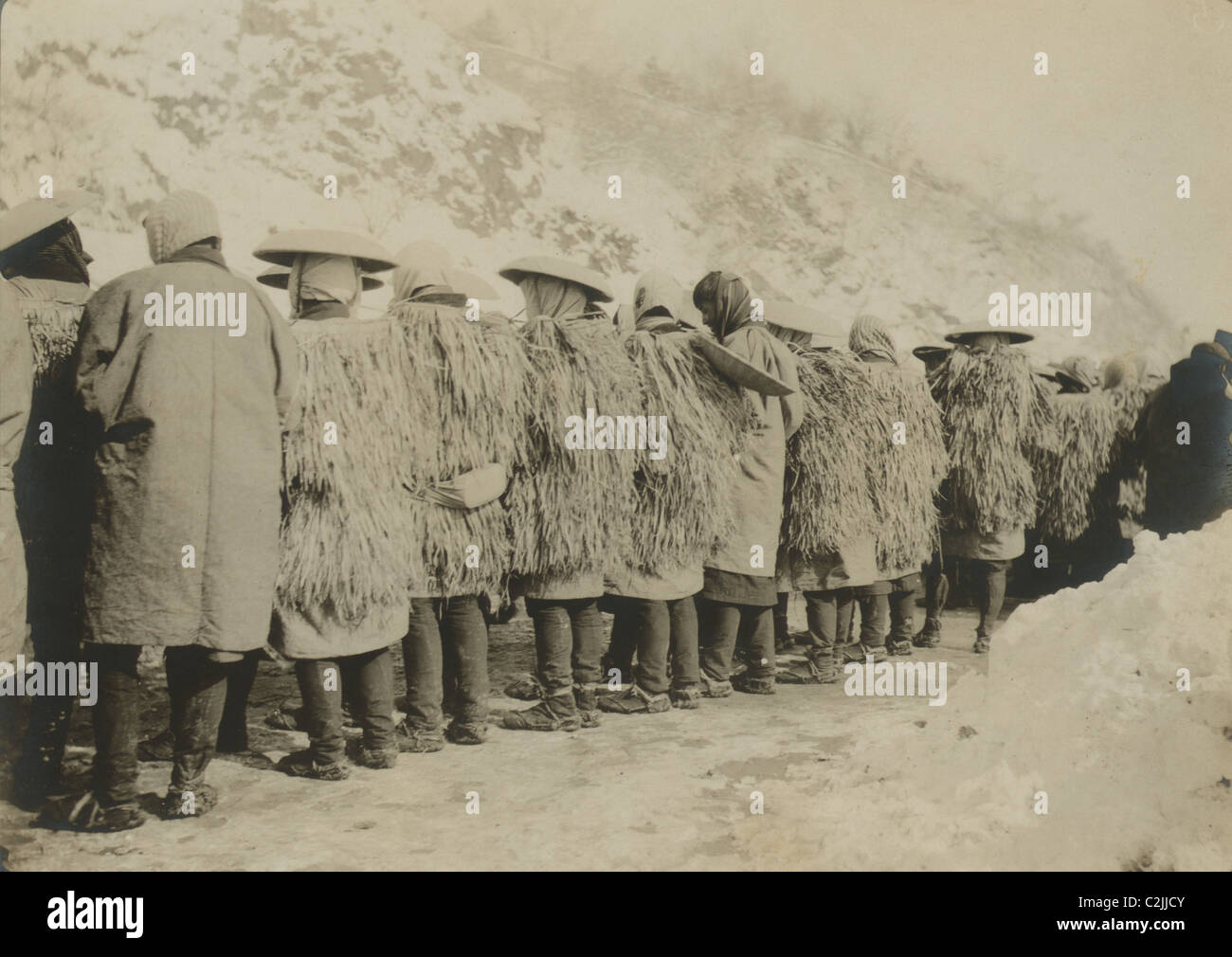 Japanese coolies in winter costume Stock Photohttps://www.alamy.com/image-license-details/?v=1https://www.alamy.com/stock-photo-japanese-coolies-in-winter-costume-36059659.html
Japanese coolies in winter costume Stock Photohttps://www.alamy.com/image-license-details/?v=1https://www.alamy.com/stock-photo-japanese-coolies-in-winter-costume-36059659.htmlRMC2JJCY–Japanese coolies in winter costume
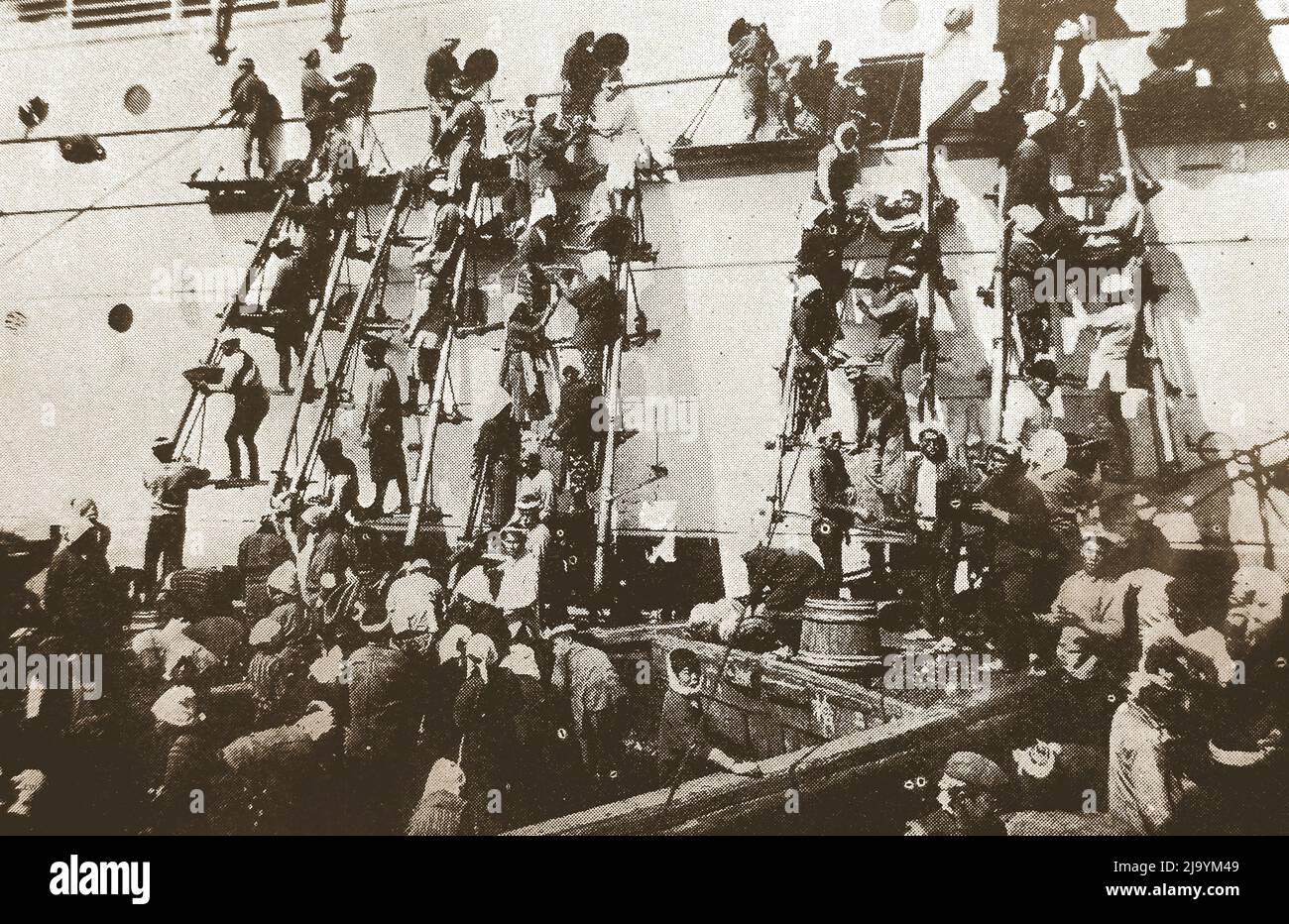 Japan - An old illustration showing workers described as 'Japanese Coolies' using ladders to fuel a large ship with coal by hand using baskets at Yokohama, circa 1930s ------ 日本 - 1930年代頃、横浜でバスケットを使って石炭を手作業で石炭で燃やすためにはしごを使った「日本のクーリー」と表現された労働者を示す古いイラスト Stock Photohttps://www.alamy.com/image-license-details/?v=1https://www.alamy.com/japan-an-old-illustration-showing-workers-described-as-japanese-coolies-using-ladders-to-fuel-a-large-ship-with-coal-by-hand-using-baskets-at-yokohama-circa-1930s-1930-image470820345.html
Japan - An old illustration showing workers described as 'Japanese Coolies' using ladders to fuel a large ship with coal by hand using baskets at Yokohama, circa 1930s ------ 日本 - 1930年代頃、横浜でバスケットを使って石炭を手作業で石炭で燃やすためにはしごを使った「日本のクーリー」と表現された労働者を示す古いイラスト Stock Photohttps://www.alamy.com/image-license-details/?v=1https://www.alamy.com/japan-an-old-illustration-showing-workers-described-as-japanese-coolies-using-ladders-to-fuel-a-large-ship-with-coal-by-hand-using-baskets-at-yokohama-circa-1930s-1930-image470820345.htmlRM2J9YM49–Japan - An old illustration showing workers described as 'Japanese Coolies' using ladders to fuel a large ship with coal by hand using baskets at Yokohama, circa 1930s ------ 日本 - 1930年代頃、横浜でバスケットを使って石炭を手作業で石炭で燃やすためにはしごを使った「日本のクーリー」と表現された労働者を示す古いイラスト
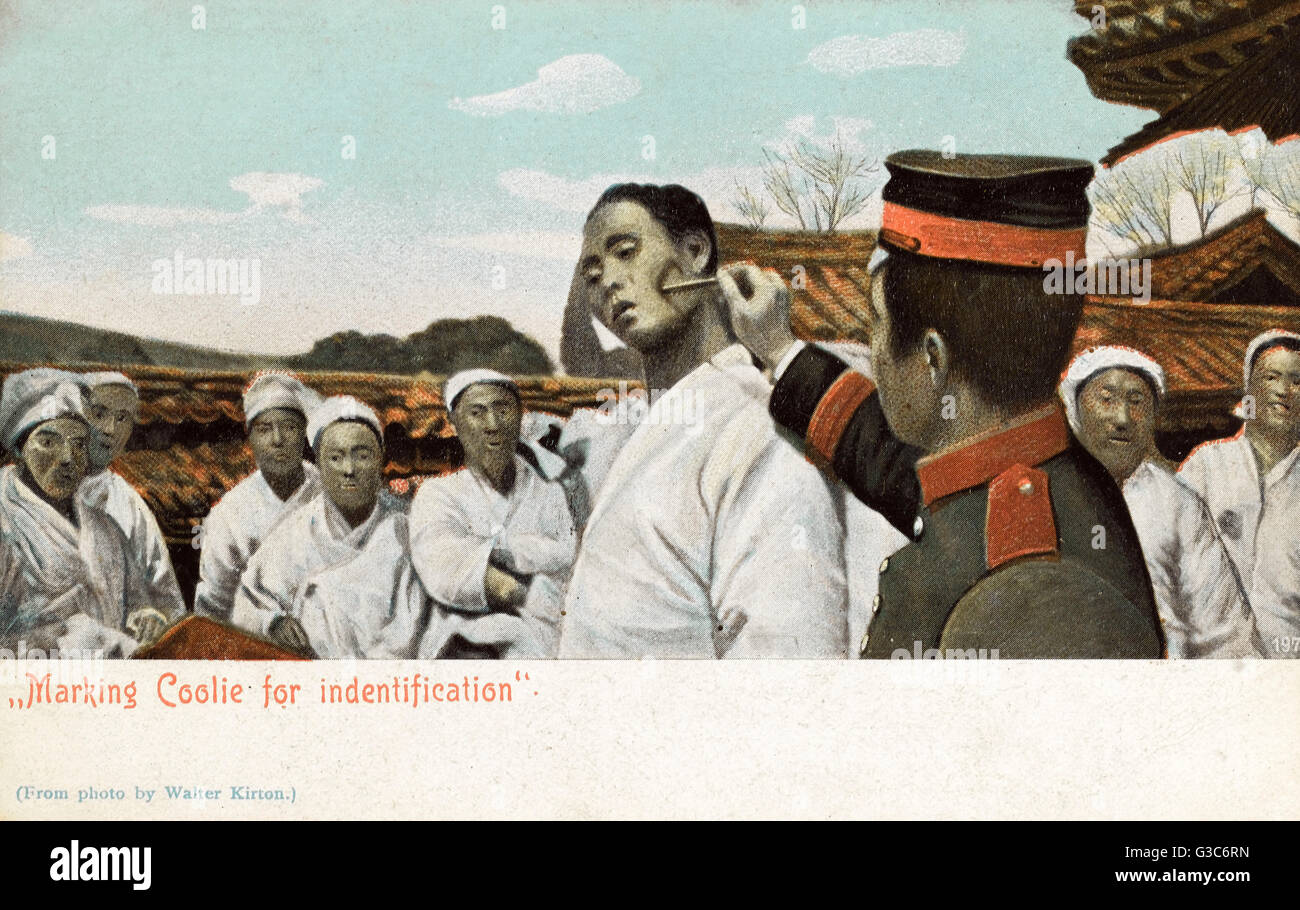 Russo-Japanese War - Japanese marking Chinese Coolies Stock Photohttps://www.alamy.com/image-license-details/?v=1https://www.alamy.com/stock-photo-russo-japanese-war-japanese-marking-chinese-coolies-105374969.html
Russo-Japanese War - Japanese marking Chinese Coolies Stock Photohttps://www.alamy.com/image-license-details/?v=1https://www.alamy.com/stock-photo-russo-japanese-war-japanese-marking-chinese-coolies-105374969.htmlRMG3C6RN–Russo-Japanese War - Japanese marking Chinese Coolies
 Coolies carrying Norimon - Japanese drawing XIX th century Stock Photohttps://www.alamy.com/image-license-details/?v=1https://www.alamy.com/coolies-carrying-norimon-japanese-drawing-xix-th-century-image66579244.html
Coolies carrying Norimon - Japanese drawing XIX th century Stock Photohttps://www.alamy.com/image-license-details/?v=1https://www.alamy.com/coolies-carrying-norimon-japanese-drawing-xix-th-century-image66579244.htmlRMDT8XE4–Coolies carrying Norimon - Japanese drawing XIX th century
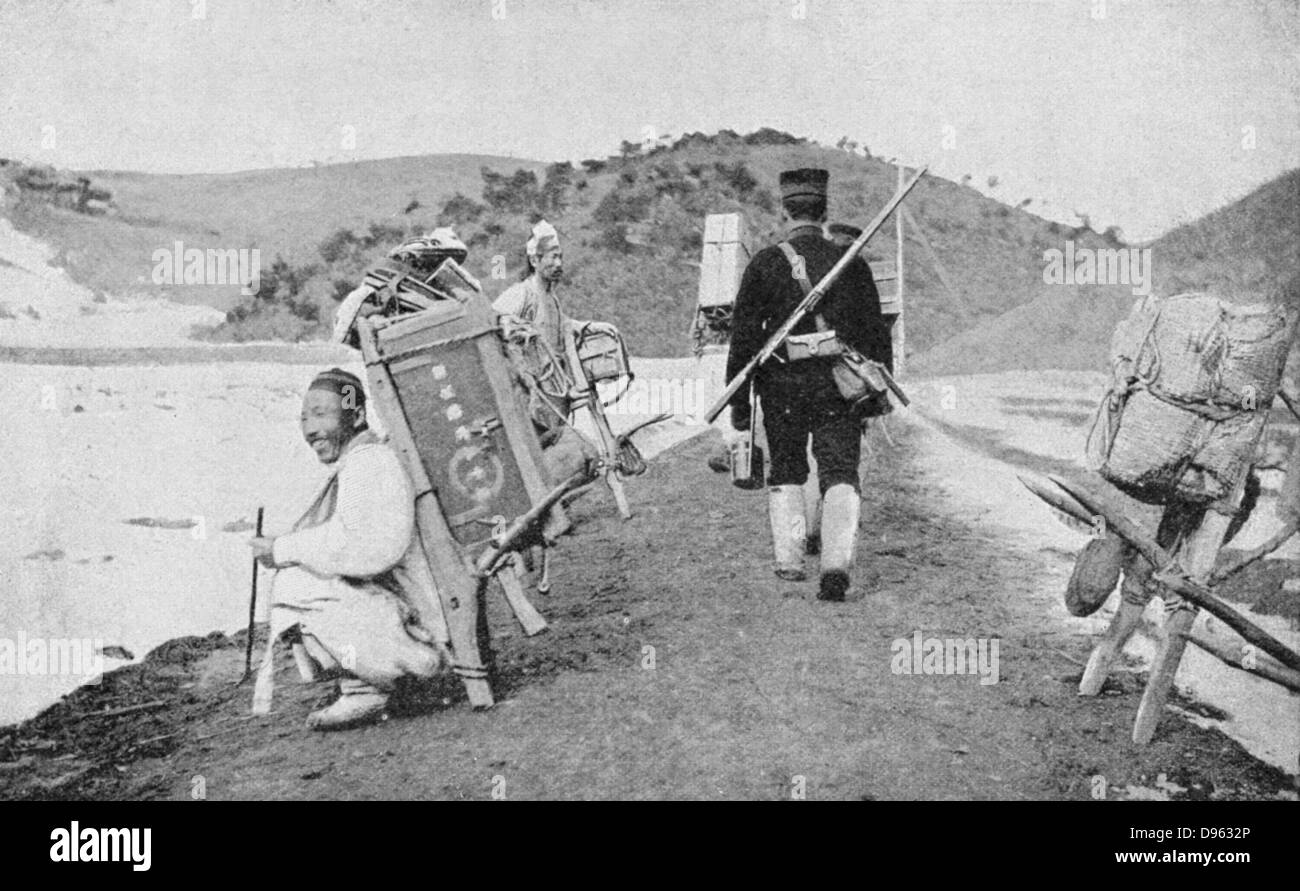 Russo-Japanese War, 1904-1905: Korean coolies acting as porters for Japanese soldiers Stock Photohttps://www.alamy.com/image-license-details/?v=1https://www.alamy.com/stock-photo-russo-japanese-war-1904-1905-korean-coolies-acting-as-porters-for-57297150.html
Russo-Japanese War, 1904-1905: Korean coolies acting as porters for Japanese soldiers Stock Photohttps://www.alamy.com/image-license-details/?v=1https://www.alamy.com/stock-photo-russo-japanese-war-1904-1905-korean-coolies-acting-as-porters-for-57297150.htmlRMD9632P–Russo-Japanese War, 1904-1905: Korean coolies acting as porters for Japanese soldiers
![[ 1890s Japan - First Sino-Japanese War (1894–1895) ] — Japanese coolies assisting Japanese troops in Korea during the First Sino-Japanese War (1894–1895). Published in the French illustrated weekly Le Monde illustré on December 29, 1894 (Meiji 27). Art by French artist Georges Ferdinand Bigot (1860-1927), famous for his satirical cartoons of life in Meiji period Japan. Original text: 'L'appel des coolies japonais. Distribution des vivres.' 19th century vintage newspaper illustration. Stock Photo [ 1890s Japan - First Sino-Japanese War (1894–1895) ] — Japanese coolies assisting Japanese troops in Korea during the First Sino-Japanese War (1894–1895). Published in the French illustrated weekly Le Monde illustré on December 29, 1894 (Meiji 27). Art by French artist Georges Ferdinand Bigot (1860-1927), famous for his satirical cartoons of life in Meiji period Japan. Original text: 'L'appel des coolies japonais. Distribution des vivres.' 19th century vintage newspaper illustration. Stock Photo](https://c8.alamy.com/comp/W9JBP6/1890s-japan-first-sino-japanese-war-18941895-japanese-coolies-assisting-japanese-troops-in-korea-during-the-first-sino-japanese-war-18941895-published-in-the-french-illustrated-weekly-le-monde-illustr-on-december-29-1894-meiji-27-art-by-french-artist-georges-ferdinand-bigot-1860-1927-famous-for-his-satirical-cartoons-of-life-in-meiji-period-japan-original-text-lappel-des-coolies-japonais-distribution-des-vivres-19th-century-vintage-newspaper-illustration-W9JBP6.jpg) [ 1890s Japan - First Sino-Japanese War (1894–1895) ] — Japanese coolies assisting Japanese troops in Korea during the First Sino-Japanese War (1894–1895). Published in the French illustrated weekly Le Monde illustré on December 29, 1894 (Meiji 27). Art by French artist Georges Ferdinand Bigot (1860-1927), famous for his satirical cartoons of life in Meiji period Japan. Original text: 'L'appel des coolies japonais. Distribution des vivres.' 19th century vintage newspaper illustration. Stock Photohttps://www.alamy.com/image-license-details/?v=1https://www.alamy.com/1890s-japan-first-sino-japanese-war-18941895-japanese-coolies-assisting-japanese-troops-in-korea-during-the-first-sino-japanese-war-18941895-published-in-the-french-illustrated-weekly-le-monde-illustr-on-december-29-1894-meiji-27-art-by-french-artist-georges-ferdinand-bigot-1860-1927-famous-for-his-satirical-cartoons-of-life-in-meiji-period-japan-original-text-lappel-des-coolies-japonais-distribution-des-vivres-19th-century-vintage-newspaper-illustration-image264091806.html
[ 1890s Japan - First Sino-Japanese War (1894–1895) ] — Japanese coolies assisting Japanese troops in Korea during the First Sino-Japanese War (1894–1895). Published in the French illustrated weekly Le Monde illustré on December 29, 1894 (Meiji 27). Art by French artist Georges Ferdinand Bigot (1860-1927), famous for his satirical cartoons of life in Meiji period Japan. Original text: 'L'appel des coolies japonais. Distribution des vivres.' 19th century vintage newspaper illustration. Stock Photohttps://www.alamy.com/image-license-details/?v=1https://www.alamy.com/1890s-japan-first-sino-japanese-war-18941895-japanese-coolies-assisting-japanese-troops-in-korea-during-the-first-sino-japanese-war-18941895-published-in-the-french-illustrated-weekly-le-monde-illustr-on-december-29-1894-meiji-27-art-by-french-artist-georges-ferdinand-bigot-1860-1927-famous-for-his-satirical-cartoons-of-life-in-meiji-period-japan-original-text-lappel-des-coolies-japonais-distribution-des-vivres-19th-century-vintage-newspaper-illustration-image264091806.htmlRMW9JBP6–[ 1890s Japan - First Sino-Japanese War (1894–1895) ] — Japanese coolies assisting Japanese troops in Korea during the First Sino-Japanese War (1894–1895). Published in the French illustrated weekly Le Monde illustré on December 29, 1894 (Meiji 27). Art by French artist Georges Ferdinand Bigot (1860-1927), famous for his satirical cartoons of life in Meiji period Japan. Original text: 'L'appel des coolies japonais. Distribution des vivres.' 19th century vintage newspaper illustration.
 Japanese coolies in winter costume Stock Photohttps://www.alamy.com/image-license-details/?v=1https://www.alamy.com/japanese-coolies-in-winter-costume-image367379407.html
Japanese coolies in winter costume Stock Photohttps://www.alamy.com/image-license-details/?v=1https://www.alamy.com/japanese-coolies-in-winter-costume-image367379407.htmlRM2C9KG53–Japanese coolies in winter costume
 Japanese coolies in winter costume Stock Photohttps://www.alamy.com/image-license-details/?v=1https://www.alamy.com/japanese-coolies-in-winter-costume-image270072177.html
Japanese coolies in winter costume Stock Photohttps://www.alamy.com/image-license-details/?v=1https://www.alamy.com/japanese-coolies-in-winter-costume-image270072177.htmlRMWKARPW–Japanese coolies in winter costume
!['Japanese Coolies Wearing Kino', 1891. From "Seas & Lands", by Sir Edwin Arnold. [Longmans, Green, and Co., London and New York, 1891] Stock Photo 'Japanese Coolies Wearing Kino', 1891. From "Seas & Lands", by Sir Edwin Arnold. [Longmans, Green, and Co., London and New York, 1891] Stock Photo](https://c8.alamy.com/comp/2AX06DC/japanese-coolies-wearing-kino-1891-from-quotseas-amp-landsquot-by-sir-edwin-arnold-longmans-green-and-co-london-and-new-york-1891-2AX06DC.jpg) 'Japanese Coolies Wearing Kino', 1891. From "Seas & Lands", by Sir Edwin Arnold. [Longmans, Green, and Co., London and New York, 1891] Stock Photohttps://www.alamy.com/image-license-details/?v=1https://www.alamy.com/japanese-coolies-wearing-kino-1891-from-quotseas-amp-landsquot-by-sir-edwin-arnold-longmans-green-and-co-london-and-new-york-1891-image342983128.html
'Japanese Coolies Wearing Kino', 1891. From "Seas & Lands", by Sir Edwin Arnold. [Longmans, Green, and Co., London and New York, 1891] Stock Photohttps://www.alamy.com/image-license-details/?v=1https://www.alamy.com/japanese-coolies-wearing-kino-1891-from-quotseas-amp-landsquot-by-sir-edwin-arnold-longmans-green-and-co-london-and-new-york-1891-image342983128.htmlRM2AX06DC–'Japanese Coolies Wearing Kino', 1891. From "Seas & Lands", by Sir Edwin Arnold. [Longmans, Green, and Co., London and New York, 1891]
 Englishman in rickshaw with Japanese attendants Stock Photohttps://www.alamy.com/image-license-details/?v=1https://www.alamy.com/englishman-in-rickshaw-with-japanese-attendants-image66164661.html
Englishman in rickshaw with Japanese attendants Stock Photohttps://www.alamy.com/image-license-details/?v=1https://www.alamy.com/englishman-in-rickshaw-with-japanese-attendants-image66164661.htmlRMDRJ1KH–Englishman in rickshaw with Japanese attendants
 A tattooed Japanese man in the 19th century. Tattooing was a mark of low breeding and vulgarity in Japan, only coolies whose work necessitated stripping the body ever had their bodies tattooed. After a 19th century photograph. Stock Photohttps://www.alamy.com/image-license-details/?v=1https://www.alamy.com/stock-photo-a-tattooed-japanese-man-in-the-19th-century-tattooing-was-a-mark-of-94969920.html
A tattooed Japanese man in the 19th century. Tattooing was a mark of low breeding and vulgarity in Japan, only coolies whose work necessitated stripping the body ever had their bodies tattooed. After a 19th century photograph. Stock Photohttps://www.alamy.com/image-license-details/?v=1https://www.alamy.com/stock-photo-a-tattooed-japanese-man-in-the-19th-century-tattooing-was-a-mark-of-94969920.htmlRMFEE72T–A tattooed Japanese man in the 19th century. Tattooing was a mark of low breeding and vulgarity in Japan, only coolies whose work necessitated stripping the body ever had their bodies tattooed. After a 19th century photograph.
 A crowd of Japanese soldiers; Chinese coolies in right foreground, Manchuria Stock Photohttps://www.alamy.com/image-license-details/?v=1https://www.alamy.com/stock-photo-a-crowd-of-japanese-soldiers-chinese-coolies-in-right-foreground-manchuria-36059646.html
A crowd of Japanese soldiers; Chinese coolies in right foreground, Manchuria Stock Photohttps://www.alamy.com/image-license-details/?v=1https://www.alamy.com/stock-photo-a-crowd-of-japanese-soldiers-chinese-coolies-in-right-foreground-manchuria-36059646.htmlRMC2JJCE–A crowd of Japanese soldiers; Chinese coolies in right foreground, Manchuria
 The Prince, Lord Louis Mountbatten (right) and Capt. Metcalfe (left) in the costumes of Japanese coolies aboard HMS Renown. The Prince of Wales tour to Japan and the Far East. May 10, 1922. (Photo by Reuterphoto). Stock Photohttps://www.alamy.com/image-license-details/?v=1https://www.alamy.com/the-prince-lord-louis-mountbatten-right-and-capt-metcalfe-left-in-the-costumes-of-japanese-coolies-aboard-hms-renown-the-prince-of-wales-tour-to-japan-and-the-far-east-may-10-1922-photo-by-reuterphoto-image471434546.html
The Prince, Lord Louis Mountbatten (right) and Capt. Metcalfe (left) in the costumes of Japanese coolies aboard HMS Renown. The Prince of Wales tour to Japan and the Far East. May 10, 1922. (Photo by Reuterphoto). Stock Photohttps://www.alamy.com/image-license-details/?v=1https://www.alamy.com/the-prince-lord-louis-mountbatten-right-and-capt-metcalfe-left-in-the-costumes-of-japanese-coolies-aboard-hms-renown-the-prince-of-wales-tour-to-japan-and-the-far-east-may-10-1922-photo-by-reuterphoto-image471434546.htmlRM2JAYKG2–The Prince, Lord Louis Mountbatten (right) and Capt. Metcalfe (left) in the costumes of Japanese coolies aboard HMS Renown. The Prince of Wales tour to Japan and the Far East. May 10, 1922. (Photo by Reuterphoto).
 Japanese ladies in rickshaws drawn by coolies, 1902. Artist: Unknown. Stock Photohttps://www.alamy.com/image-license-details/?v=1https://www.alamy.com/japanese-ladies-in-rickshaws-drawn-by-coolies-1902-artist-unknown-image186094473.html
Japanese ladies in rickshaws drawn by coolies, 1902. Artist: Unknown. Stock Photohttps://www.alamy.com/image-license-details/?v=1https://www.alamy.com/japanese-ladies-in-rickshaws-drawn-by-coolies-1902-artist-unknown-image186094473.htmlRMMPN9B5–Japanese ladies in rickshaws drawn by coolies, 1902. Artist: Unknown.
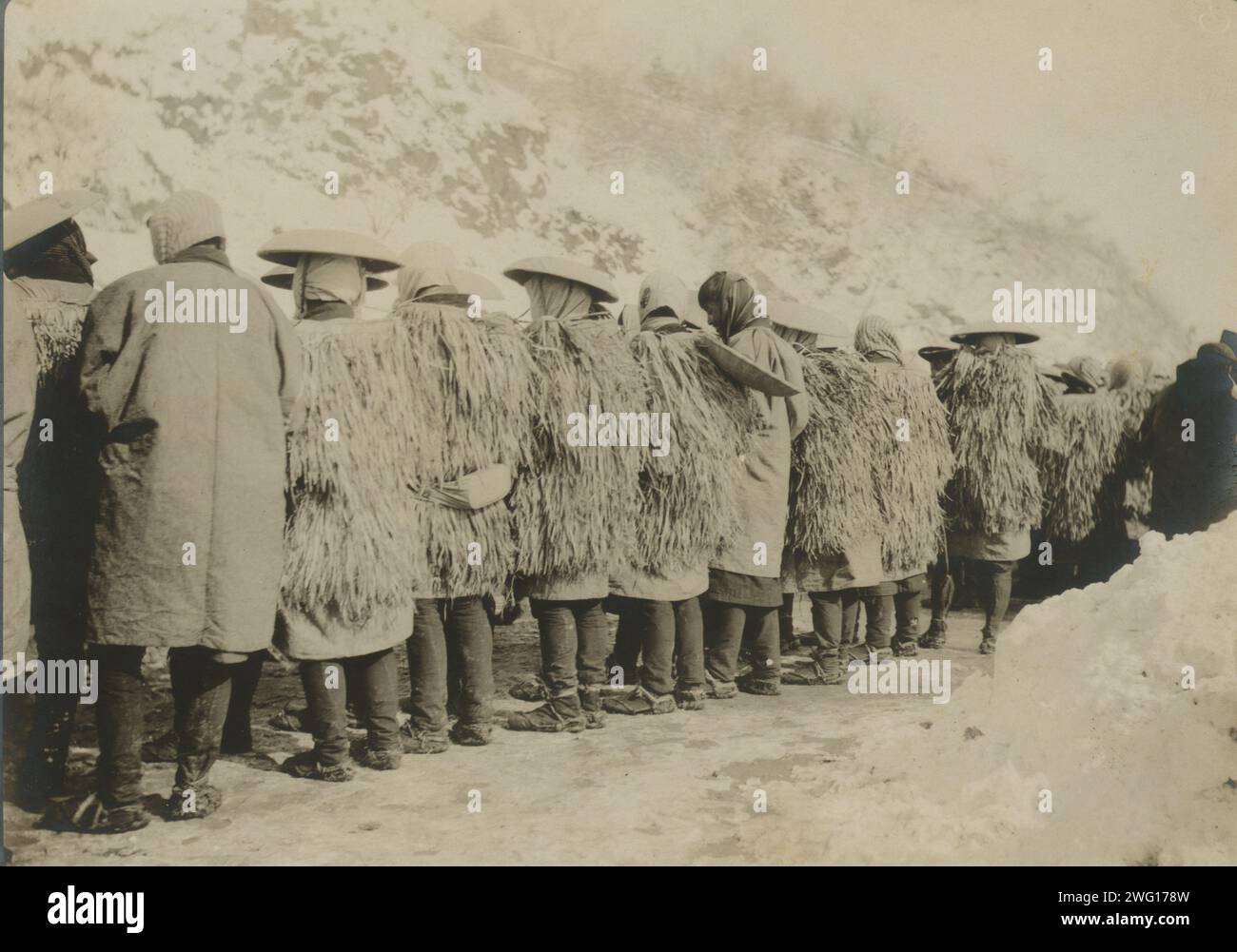 Japanese coolies in winter costume, c1904. Stock Photohttps://www.alamy.com/image-license-details/?v=1https://www.alamy.com/japanese-coolies-in-winter-costume-c1904-image595014697.html
Japanese coolies in winter costume, c1904. Stock Photohttps://www.alamy.com/image-license-details/?v=1https://www.alamy.com/japanese-coolies-in-winter-costume-c1904-image595014697.htmlRM2WG178W–Japanese coolies in winter costume, c1904.
 Coolies Wayside Refreshments; Kusakabe Kimbei, Japanese, 1841 - 1934, active 1880s - about 1912, Japan; 1870s - 1890s Stock Photohttps://www.alamy.com/image-license-details/?v=1https://www.alamy.com/coolies-wayside-refreshments-kusakabe-kimbei-japanese-1841-1934-active-1880s-about-1912-japan-1870s-1890s-image220662817.html
Coolies Wayside Refreshments; Kusakabe Kimbei, Japanese, 1841 - 1934, active 1880s - about 1912, Japan; 1870s - 1890s Stock Photohttps://www.alamy.com/image-license-details/?v=1https://www.alamy.com/coolies-wayside-refreshments-kusakabe-kimbei-japanese-1841-1934-active-1880s-about-1912-japan-1870s-1890s-image220662817.htmlRMPR01JW–Coolies Wayside Refreshments; Kusakabe Kimbei, Japanese, 1841 - 1934, active 1880s - about 1912, Japan; 1870s - 1890s
 Coolies to War Stock Photohttps://www.alamy.com/image-license-details/?v=1https://www.alamy.com/stock-photo-coolies-to-war-36062493.html
Coolies to War Stock Photohttps://www.alamy.com/image-license-details/?v=1https://www.alamy.com/stock-photo-coolies-to-war-36062493.htmlRMC2JP25–Coolies to War
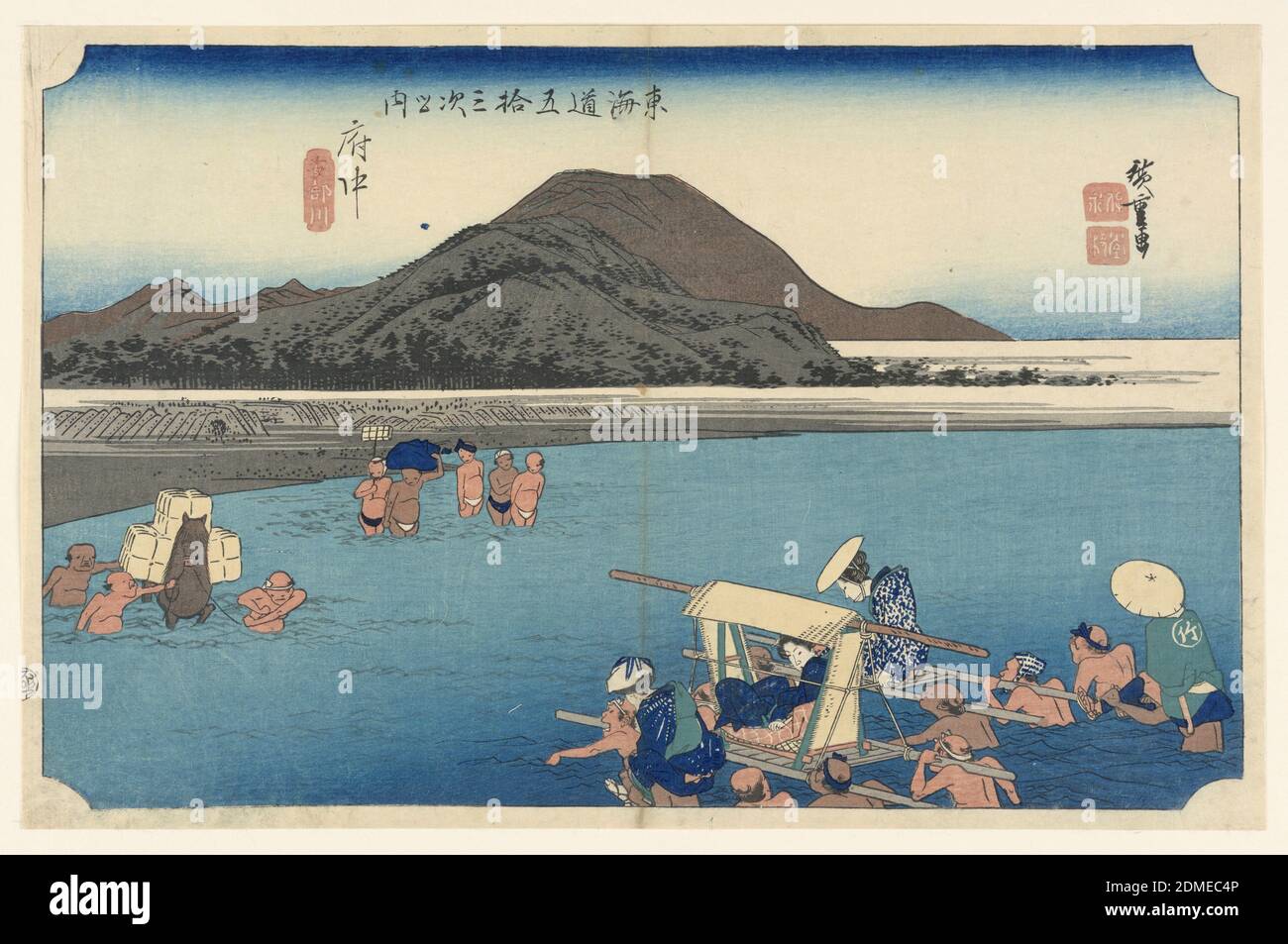 Fuchu, Abe River, in The Fifty-Three Stations of the Tokaido Road (Tokaido Gojusan Tsugi-no Uchi), Ando Hiroshige, Japanese, 1797–1858, Woodblock print in colored ink on paper, Lower right, women are carried across ford. Left, coolies lead pack-horse and others carry loads. Upper half, large hills stretch away to the distance beyond the farther bank., Japan, ca. 1834, landscapes, Print Stock Photohttps://www.alamy.com/image-license-details/?v=1https://www.alamy.com/fuchu-abe-river-in-the-fifty-three-stations-of-the-tokaido-road-tokaido-gojusan-tsugi-no-uchi-ando-hiroshige-japanese-17971858-woodblock-print-in-colored-ink-on-paper-lower-right-women-are-carried-across-ford-left-coolies-lead-pack-horse-and-others-carry-loads-upper-half-large-hills-stretch-away-to-the-distance-beyond-the-farther-bank-japan-ca-1834-landscapes-print-image391238086.html
Fuchu, Abe River, in The Fifty-Three Stations of the Tokaido Road (Tokaido Gojusan Tsugi-no Uchi), Ando Hiroshige, Japanese, 1797–1858, Woodblock print in colored ink on paper, Lower right, women are carried across ford. Left, coolies lead pack-horse and others carry loads. Upper half, large hills stretch away to the distance beyond the farther bank., Japan, ca. 1834, landscapes, Print Stock Photohttps://www.alamy.com/image-license-details/?v=1https://www.alamy.com/fuchu-abe-river-in-the-fifty-three-stations-of-the-tokaido-road-tokaido-gojusan-tsugi-no-uchi-ando-hiroshige-japanese-17971858-woodblock-print-in-colored-ink-on-paper-lower-right-women-are-carried-across-ford-left-coolies-lead-pack-horse-and-others-carry-loads-upper-half-large-hills-stretch-away-to-the-distance-beyond-the-farther-bank-japan-ca-1834-landscapes-print-image391238086.htmlRM2DMEC4P–Fuchu, Abe River, in The Fifty-Three Stations of the Tokaido Road (Tokaido Gojusan Tsugi-no Uchi), Ando Hiroshige, Japanese, 1797–1858, Woodblock print in colored ink on paper, Lower right, women are carried across ford. Left, coolies lead pack-horse and others carry loads. Upper half, large hills stretch away to the distance beyond the farther bank., Japan, ca. 1834, landscapes, Print
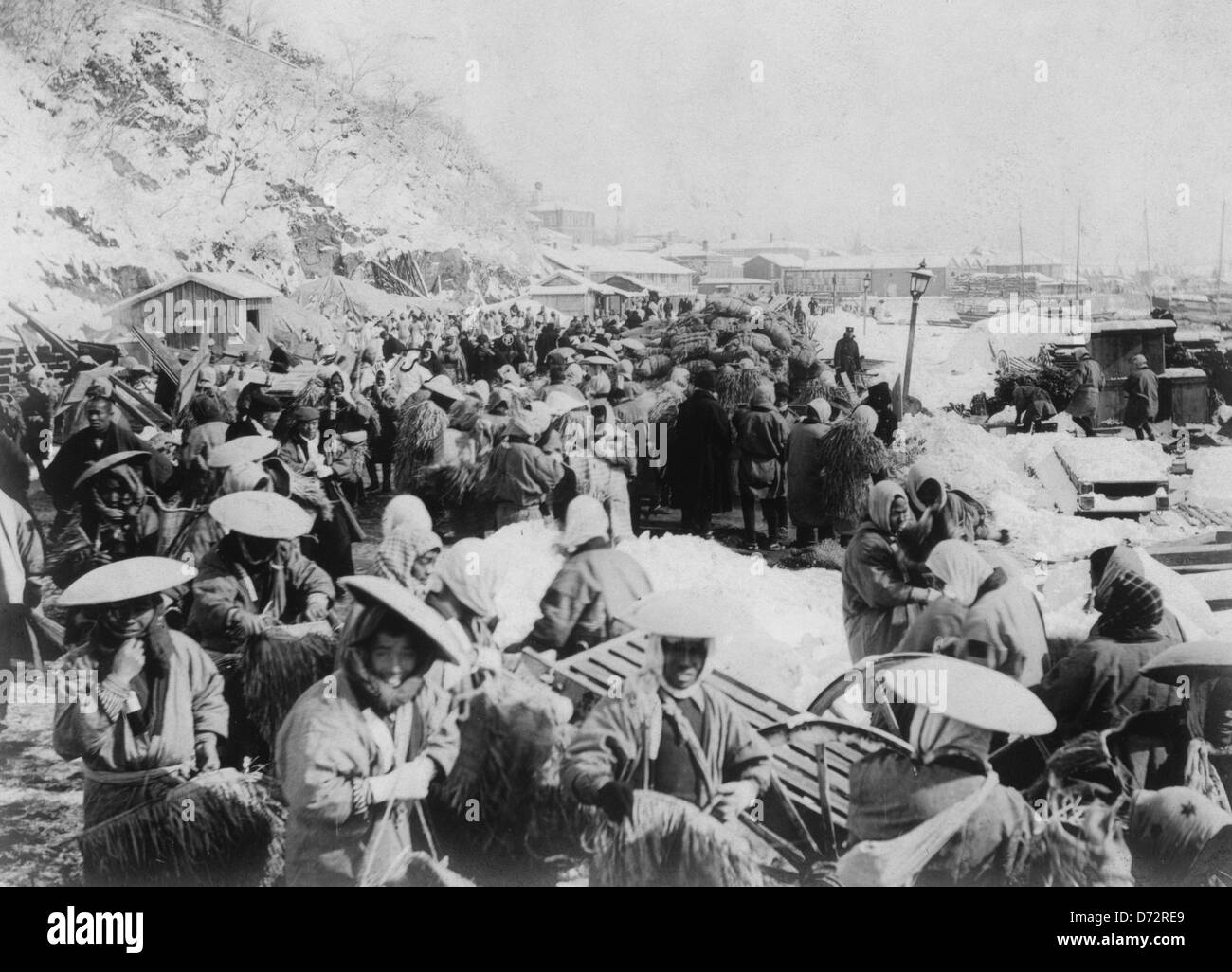 Japanese and Korean coolies removing supplies from wharf of Chemulpo, Korea during the Russo Japanese War, 1904 Stock Photohttps://www.alamy.com/image-license-details/?v=1https://www.alamy.com/stock-photo-japanese-and-korean-coolies-removing-supplies-from-wharf-of-chemulpo-55996033.html
Japanese and Korean coolies removing supplies from wharf of Chemulpo, Korea during the Russo Japanese War, 1904 Stock Photohttps://www.alamy.com/image-license-details/?v=1https://www.alamy.com/stock-photo-japanese-and-korean-coolies-removing-supplies-from-wharf-of-chemulpo-55996033.htmlRMD72RE9–Japanese and Korean coolies removing supplies from wharf of Chemulpo, Korea during the Russo Japanese War, 1904
 Fording the Sakawa River (Odawara), in The Fifty-Three Stations of the Tokaido Road (Tokaido Gojusan Tsugi-no Uchi), Ando Hiroshige, Japanese, 1797–1858, Woodblock print in colored ink on paper, Center, travelers fording the Sakawa River, in the middle of which is a litter. Right, rice fields and mountains at the foot of a castle. Lower left, two coolies on bank. Sharp outliine of distant hills., Japan, ca. 1834, landscapes, Print Stock Photohttps://www.alamy.com/image-license-details/?v=1https://www.alamy.com/fording-the-sakawa-river-odawara-in-the-fifty-three-stations-of-the-tokaido-road-tokaido-gojusan-tsugi-no-uchi-ando-hiroshige-japanese-17971858-woodblock-print-in-colored-ink-on-paper-center-travelers-fording-the-sakawa-river-in-the-middle-of-which-is-a-litter-right-rice-fields-and-mountains-at-the-foot-of-a-castle-lower-left-two-coolies-on-bank-sharp-outliine-of-distant-hills-japan-ca-1834-landscapes-print-image391484566.html
Fording the Sakawa River (Odawara), in The Fifty-Three Stations of the Tokaido Road (Tokaido Gojusan Tsugi-no Uchi), Ando Hiroshige, Japanese, 1797–1858, Woodblock print in colored ink on paper, Center, travelers fording the Sakawa River, in the middle of which is a litter. Right, rice fields and mountains at the foot of a castle. Lower left, two coolies on bank. Sharp outliine of distant hills., Japan, ca. 1834, landscapes, Print Stock Photohttps://www.alamy.com/image-license-details/?v=1https://www.alamy.com/fording-the-sakawa-river-odawara-in-the-fifty-three-stations-of-the-tokaido-road-tokaido-gojusan-tsugi-no-uchi-ando-hiroshige-japanese-17971858-woodblock-print-in-colored-ink-on-paper-center-travelers-fording-the-sakawa-river-in-the-middle-of-which-is-a-litter-right-rice-fields-and-mountains-at-the-foot-of-a-castle-lower-left-two-coolies-on-bank-sharp-outliine-of-distant-hills-japan-ca-1834-landscapes-print-image391484566.htmlRM2DMWJFJ–Fording the Sakawa River (Odawara), in The Fifty-Three Stations of the Tokaido Road (Tokaido Gojusan Tsugi-no Uchi), Ando Hiroshige, Japanese, 1797–1858, Woodblock print in colored ink on paper, Center, travelers fording the Sakawa River, in the middle of which is a litter. Right, rice fields and mountains at the foot of a castle. Lower left, two coolies on bank. Sharp outliine of distant hills., Japan, ca. 1834, landscapes, Print
 Vintage photo of rice culture in Japan. A coolie's small patch. 1902 Stock Photohttps://www.alamy.com/image-license-details/?v=1https://www.alamy.com/vintage-photo-of-rice-culture-in-japan-a-coolies-small-patch-1902-image624387542.html
Vintage photo of rice culture in Japan. A coolie's small patch. 1902 Stock Photohttps://www.alamy.com/image-license-details/?v=1https://www.alamy.com/vintage-photo-of-rice-culture-in-japan-a-coolies-small-patch-1902-image624387542.htmlRF2Y7R8K2–Vintage photo of rice culture in Japan. A coolie's small patch. 1902
 Kusatsu, A Station Famous for its Rice Cakes, in The Fifty-Three Stations of the Tokaido Road (Tokaido Gojusan Tsugi-no Uchi), Ando Hiroshige, Japanese, 1797–1858, Woodblock print (ukiyo-e) on mulberry paper (washi), ink with color, Large teahouse with travelers eating rice cakes which are being made under the veranda. Lower half, two litters, one open and one closed, both carried by coolies., Japan, ca. 1834, figures, Print Stock Photohttps://www.alamy.com/image-license-details/?v=1https://www.alamy.com/kusatsu-a-station-famous-for-its-rice-cakes-in-the-fifty-three-stations-of-the-tokaido-road-tokaido-gojusan-tsugi-no-uchi-ando-hiroshige-japanese-17971858-woodblock-print-ukiyo-e-on-mulberry-paper-washi-ink-with-color-large-teahouse-with-travelers-eating-rice-cakes-which-are-being-made-under-the-veranda-lower-half-two-litters-one-open-and-one-closed-both-carried-by-coolies-japan-ca-1834-figures-print-image391213347.html
Kusatsu, A Station Famous for its Rice Cakes, in The Fifty-Three Stations of the Tokaido Road (Tokaido Gojusan Tsugi-no Uchi), Ando Hiroshige, Japanese, 1797–1858, Woodblock print (ukiyo-e) on mulberry paper (washi), ink with color, Large teahouse with travelers eating rice cakes which are being made under the veranda. Lower half, two litters, one open and one closed, both carried by coolies., Japan, ca. 1834, figures, Print Stock Photohttps://www.alamy.com/image-license-details/?v=1https://www.alamy.com/kusatsu-a-station-famous-for-its-rice-cakes-in-the-fifty-three-stations-of-the-tokaido-road-tokaido-gojusan-tsugi-no-uchi-ando-hiroshige-japanese-17971858-woodblock-print-ukiyo-e-on-mulberry-paper-washi-ink-with-color-large-teahouse-with-travelers-eating-rice-cakes-which-are-being-made-under-the-veranda-lower-half-two-litters-one-open-and-one-closed-both-carried-by-coolies-japan-ca-1834-figures-print-image391213347.htmlRM2DMD8H7–Kusatsu, A Station Famous for its Rice Cakes, in The Fifty-Three Stations of the Tokaido Road (Tokaido Gojusan Tsugi-no Uchi), Ando Hiroshige, Japanese, 1797–1858, Woodblock print (ukiyo-e) on mulberry paper (washi), ink with color, Large teahouse with travelers eating rice cakes which are being made under the veranda. Lower half, two litters, one open and one closed, both carried by coolies., Japan, ca. 1834, figures, Print
 Coolies Stock Photohttps://www.alamy.com/image-license-details/?v=1https://www.alamy.com/coolies-image179282153.html
Coolies Stock Photohttps://www.alamy.com/image-license-details/?v=1https://www.alamy.com/coolies-image179282153.htmlRMMBK061–Coolies
 Russo-Japanese War 1904-1905: Japanese and Korean coolies removing supplies from the wharf at Chemulpo, Korea, 1904. Stock Photohttps://www.alamy.com/image-license-details/?v=1https://www.alamy.com/stock-photo-russo-japanese-war-1904-1905-japanese-and-korean-coolies-removing-57355648.html
Russo-Japanese War 1904-1905: Japanese and Korean coolies removing supplies from the wharf at Chemulpo, Korea, 1904. Stock Photohttps://www.alamy.com/image-license-details/?v=1https://www.alamy.com/stock-photo-russo-japanese-war-1904-1905-japanese-and-korean-coolies-removing-57355648.htmlRMD98NM0–Russo-Japanese War 1904-1905: Japanese and Korean coolies removing supplies from the wharf at Chemulpo, Korea, 1904.
 Japanese Ladies in jinrickshaws Drawn by Coolies from The living races of mankind : a popular illustrated account of the customs, habits, pursuits, feasts & ceremonies of the races of mankind throughout the world Volume 1 by Sir Harry Hamilton Johnston, Henry Neville Hutchinson, Richard Lydekker and Dr. A. H. Keane published London : Hutchinson & Co. 1902 Stock Photohttps://www.alamy.com/image-license-details/?v=1https://www.alamy.com/japanese-ladies-in-jinrickshaws-drawn-by-coolies-from-the-living-races-of-mankind-a-popular-illustrated-account-of-the-customs-habits-pursuits-feasts-ceremonies-of-the-races-of-mankind-throughout-the-world-volume-1-by-sir-harry-hamilton-johnston-henry-neville-hutchinson-richard-lydekker-and-dr-a-h-keane-published-london-hutchinson-co-1902-image460980744.html
Japanese Ladies in jinrickshaws Drawn by Coolies from The living races of mankind : a popular illustrated account of the customs, habits, pursuits, feasts & ceremonies of the races of mankind throughout the world Volume 1 by Sir Harry Hamilton Johnston, Henry Neville Hutchinson, Richard Lydekker and Dr. A. H. Keane published London : Hutchinson & Co. 1902 Stock Photohttps://www.alamy.com/image-license-details/?v=1https://www.alamy.com/japanese-ladies-in-jinrickshaws-drawn-by-coolies-from-the-living-races-of-mankind-a-popular-illustrated-account-of-the-customs-habits-pursuits-feasts-ceremonies-of-the-races-of-mankind-throughout-the-world-volume-1-by-sir-harry-hamilton-johnston-henry-neville-hutchinson-richard-lydekker-and-dr-a-h-keane-published-london-hutchinson-co-1902-image460980744.htmlRF2HNYDJ0–Japanese Ladies in jinrickshaws Drawn by Coolies from The living races of mankind : a popular illustrated account of the customs, habits, pursuits, feasts & ceremonies of the races of mankind throughout the world Volume 1 by Sir Harry Hamilton Johnston, Henry Neville Hutchinson, Richard Lydekker and Dr. A. H. Keane published London : Hutchinson & Co. 1902
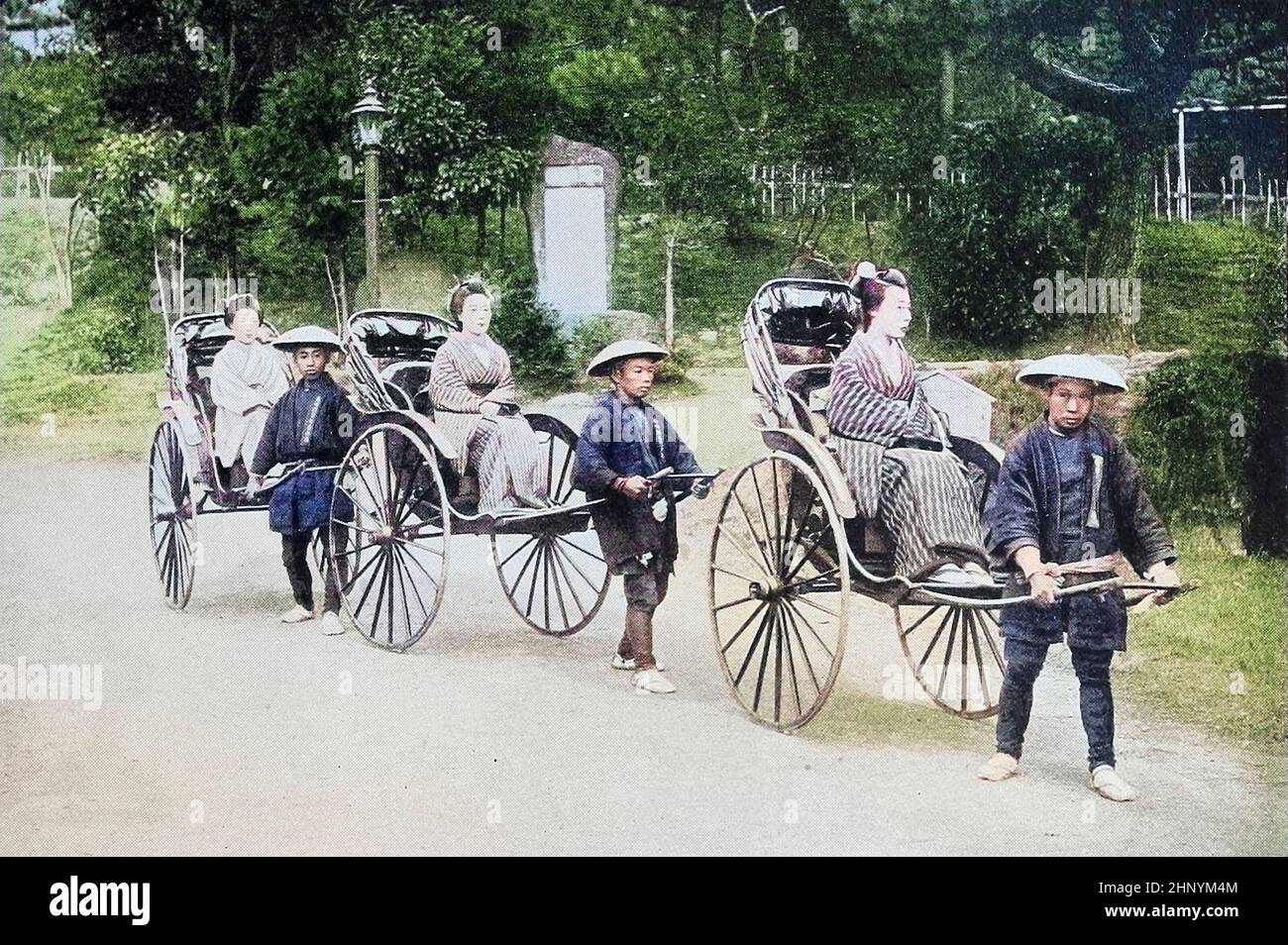 Machine Colorized Japanese Ladies in jinrickshaws Drawn by Coolies from The living races of mankind : a popular illustrated account of the customs, habits, pursuits, feasts & ceremonies of the races of mankind throughout the world Volume 1 by Sir Harry Hamilton Johnston, Henry Neville Hutchinson, Richard Lydekker and Dr. A. H. Keane published London : Hutchinson & Co. 1902 Stock Photohttps://www.alamy.com/image-license-details/?v=1https://www.alamy.com/machine-colorized-japanese-ladies-in-jinrickshaws-drawn-by-coolies-from-the-living-races-of-mankind-a-popular-illustrated-account-of-the-customs-habits-pursuits-feasts-ceremonies-of-the-races-of-mankind-throughout-the-world-volume-1-by-sir-harry-hamilton-johnston-henry-neville-hutchinson-richard-lydekker-and-dr-a-h-keane-published-london-hutchinson-co-1902-image460985860.html
Machine Colorized Japanese Ladies in jinrickshaws Drawn by Coolies from The living races of mankind : a popular illustrated account of the customs, habits, pursuits, feasts & ceremonies of the races of mankind throughout the world Volume 1 by Sir Harry Hamilton Johnston, Henry Neville Hutchinson, Richard Lydekker and Dr. A. H. Keane published London : Hutchinson & Co. 1902 Stock Photohttps://www.alamy.com/image-license-details/?v=1https://www.alamy.com/machine-colorized-japanese-ladies-in-jinrickshaws-drawn-by-coolies-from-the-living-races-of-mankind-a-popular-illustrated-account-of-the-customs-habits-pursuits-feasts-ceremonies-of-the-races-of-mankind-throughout-the-world-volume-1-by-sir-harry-hamilton-johnston-henry-neville-hutchinson-richard-lydekker-and-dr-a-h-keane-published-london-hutchinson-co-1902-image460985860.htmlRF2HNYM4M–Machine Colorized Japanese Ladies in jinrickshaws Drawn by Coolies from The living races of mankind : a popular illustrated account of the customs, habits, pursuits, feasts & ceremonies of the races of mankind throughout the world Volume 1 by Sir Harry Hamilton Johnston, Henry Neville Hutchinson, Richard Lydekker and Dr. A. H. Keane published London : Hutchinson & Co. 1902
 Kusatsu: View of a rest-house for coolies and horses on the road; coolies passing in foreground with a kago and a covered palanquin. The Nakasendo, another large highway which ran through the mountainous region between Edo and Kyoto joined the Tokaido at this station to form a single highway for the remainder of the highway to Kyoto. Utagawa Hiroshige (歌川 広重, 1797 – October 12, 1858) was a Japanese ukiyo-e artist, and one of the last great artists in that tradition. He was also referred to as Andō Hiroshige (安藤 広重) (an irregular combination of family name and art name) and by the art name of Stock Photohttps://www.alamy.com/image-license-details/?v=1https://www.alamy.com/kusatsu-view-of-a-rest-house-for-coolies-and-horses-on-the-road-coolies-passing-in-foreground-with-a-kago-and-a-covered-palanquin-the-nakasendo-another-large-highway-which-ran-through-the-mountainous-region-between-edo-and-kyoto-joined-the-tokaido-at-this-station-to-form-a-single-highway-for-the-remainder-of-the-highway-to-kyoto-utagawa-hiroshige-1797-october-12-1858-was-a-japanese-ukiyo-e-artist-and-one-of-the-last-great-artists-in-that-tradition-he-was-also-referred-to-as-and-hiroshige-an-irregular-combination-of-family-name-and-art-name-and-by-the-art-name-of-image344252541.html
Kusatsu: View of a rest-house for coolies and horses on the road; coolies passing in foreground with a kago and a covered palanquin. The Nakasendo, another large highway which ran through the mountainous region between Edo and Kyoto joined the Tokaido at this station to form a single highway for the remainder of the highway to Kyoto. Utagawa Hiroshige (歌川 広重, 1797 – October 12, 1858) was a Japanese ukiyo-e artist, and one of the last great artists in that tradition. He was also referred to as Andō Hiroshige (安藤 広重) (an irregular combination of family name and art name) and by the art name of Stock Photohttps://www.alamy.com/image-license-details/?v=1https://www.alamy.com/kusatsu-view-of-a-rest-house-for-coolies-and-horses-on-the-road-coolies-passing-in-foreground-with-a-kago-and-a-covered-palanquin-the-nakasendo-another-large-highway-which-ran-through-the-mountainous-region-between-edo-and-kyoto-joined-the-tokaido-at-this-station-to-form-a-single-highway-for-the-remainder-of-the-highway-to-kyoto-utagawa-hiroshige-1797-october-12-1858-was-a-japanese-ukiyo-e-artist-and-one-of-the-last-great-artists-in-that-tradition-he-was-also-referred-to-as-and-hiroshige-an-irregular-combination-of-family-name-and-art-name-and-by-the-art-name-of-image344252541.htmlRM2B021HH–Kusatsu: View of a rest-house for coolies and horses on the road; coolies passing in foreground with a kago and a covered palanquin. The Nakasendo, another large highway which ran through the mountainous region between Edo and Kyoto joined the Tokaido at this station to form a single highway for the remainder of the highway to Kyoto. Utagawa Hiroshige (歌川 広重, 1797 – October 12, 1858) was a Japanese ukiyo-e artist, and one of the last great artists in that tradition. He was also referred to as Andō Hiroshige (安藤 広重) (an irregular combination of family name and art name) and by the art name of
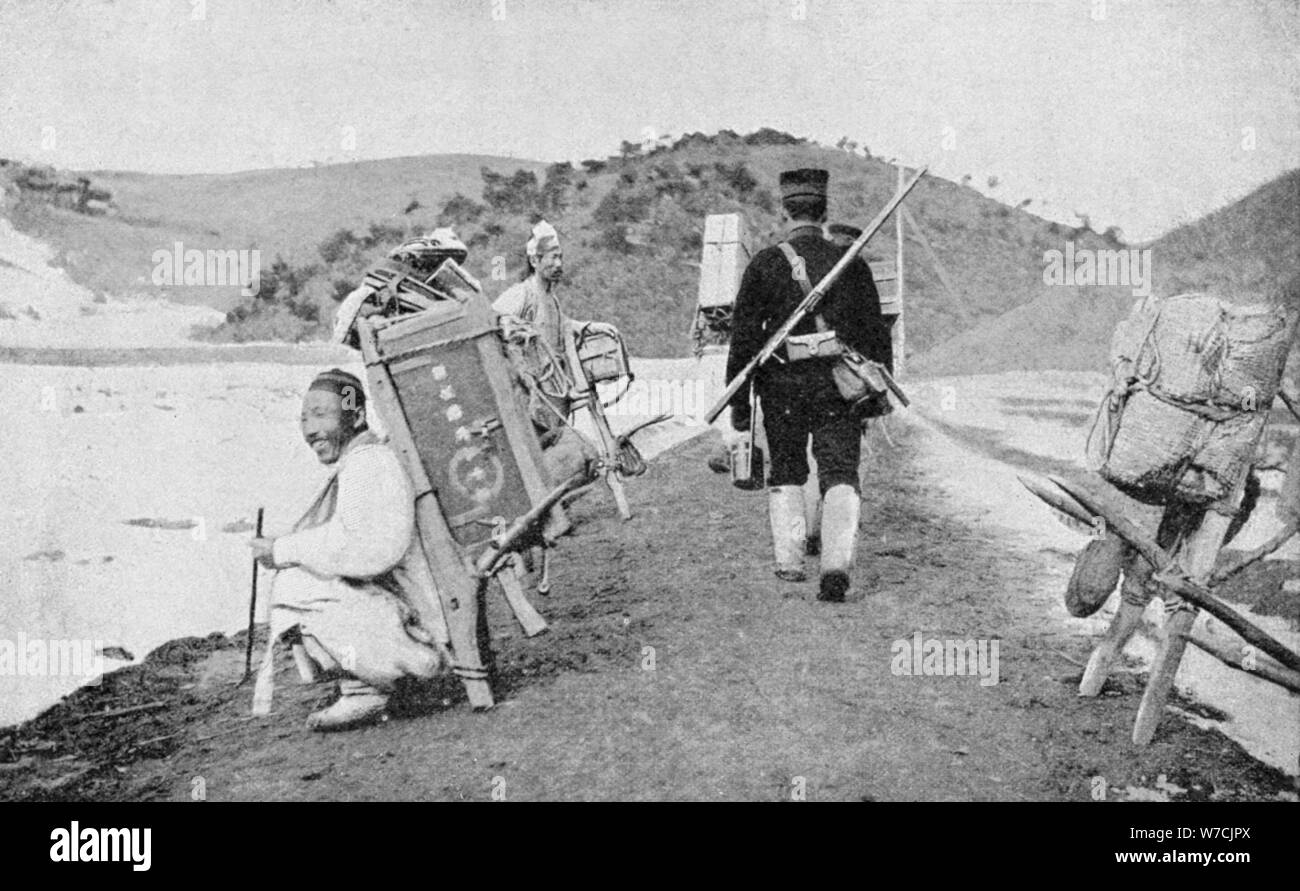 Korean coolies acting as porters for Japanese soldiers, Russo-Japanese War, 1904-5. Artist: Unknown Stock Photohttps://www.alamy.com/image-license-details/?v=1https://www.alamy.com/korean-coolies-acting-as-porters-for-japanese-soldiers-russo-japanese-war-1904-5-artist-unknown-image262736290.html
Korean coolies acting as porters for Japanese soldiers, Russo-Japanese War, 1904-5. Artist: Unknown Stock Photohttps://www.alamy.com/image-license-details/?v=1https://www.alamy.com/korean-coolies-acting-as-porters-for-japanese-soldiers-russo-japanese-war-1904-5-artist-unknown-image262736290.htmlRMW7CJPX–Korean coolies acting as porters for Japanese soldiers, Russo-Japanese War, 1904-5. Artist: Unknown
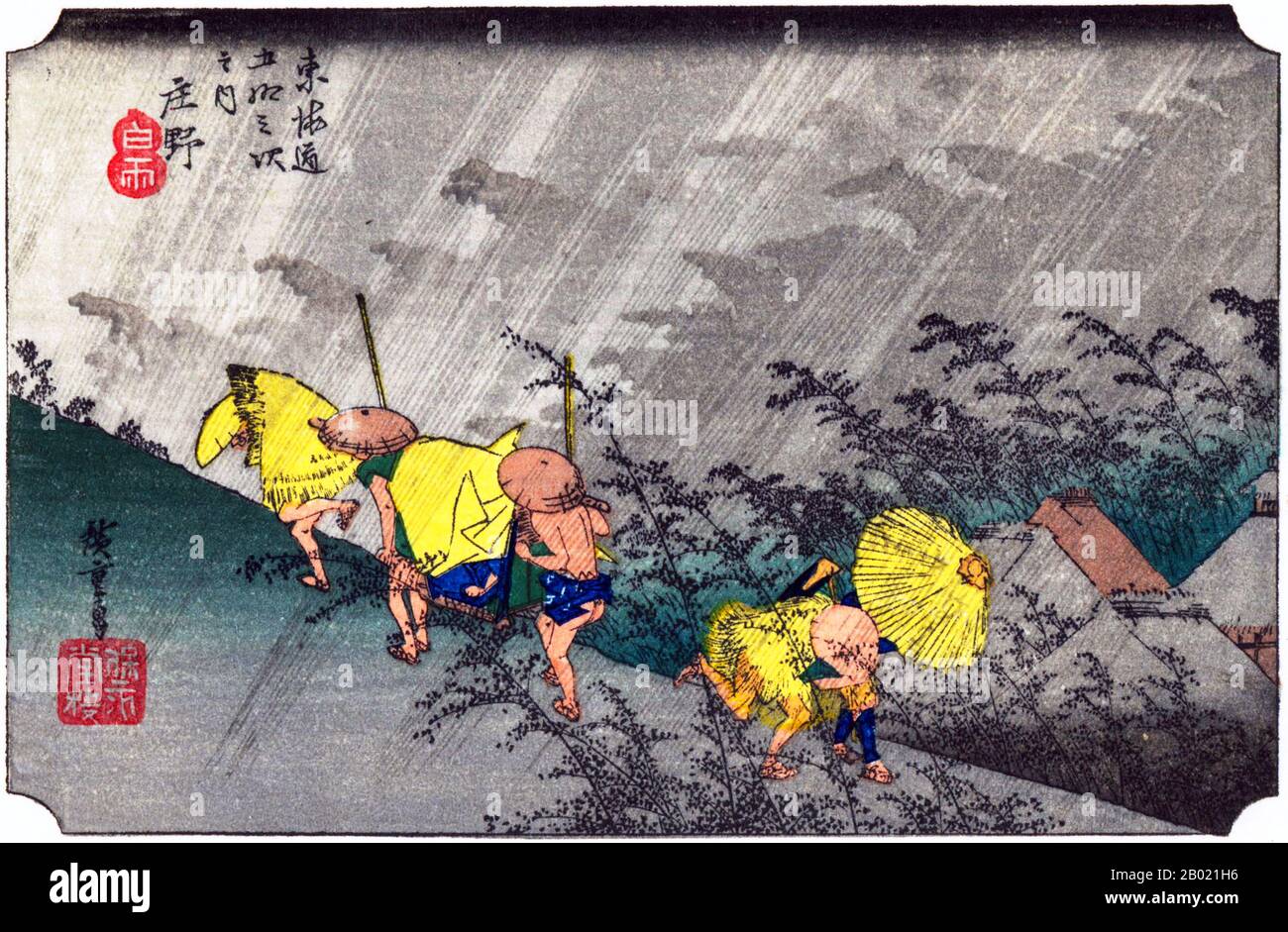 Shono: Rainstorm in the mountains; coolies carrying a kago, with a straw coat thrown over it, up the hill, and two others, one with an umbrella, rushing down. Utagawa Hiroshige (歌川 広重, 1797 – October 12, 1858) was a Japanese ukiyo-e artist, and one of the last great artists in that tradition. He was also referred to as Andō Hiroshige (安藤 広重) (an irregular combination of family name and art name) and by the art name of Ichiyūsai Hiroshige (一幽斎廣重). The Tōkaidō (東海道 East Sea Road) was the most important of the Five Routes of the Edo period, connecting Edo (modern-day Tokyo) to Kyoto in Japan. U Stock Photohttps://www.alamy.com/image-license-details/?v=1https://www.alamy.com/shono-rainstorm-in-the-mountains-coolies-carrying-a-kago-with-a-straw-coat-thrown-over-it-up-the-hill-and-two-others-one-with-an-umbrella-rushing-down-utagawa-hiroshige-1797-october-12-1858-was-a-japanese-ukiyo-e-artist-and-one-of-the-last-great-artists-in-that-tradition-he-was-also-referred-to-as-and-hiroshige-an-irregular-combination-of-family-name-and-art-name-and-by-the-art-name-of-ichiysai-hiroshige-the-tkaid-east-sea-road-was-the-most-important-of-the-five-routes-of-the-edo-period-connecting-edo-modern-day-tokyo-to-kyoto-in-japan-u-image344252530.html
Shono: Rainstorm in the mountains; coolies carrying a kago, with a straw coat thrown over it, up the hill, and two others, one with an umbrella, rushing down. Utagawa Hiroshige (歌川 広重, 1797 – October 12, 1858) was a Japanese ukiyo-e artist, and one of the last great artists in that tradition. He was also referred to as Andō Hiroshige (安藤 広重) (an irregular combination of family name and art name) and by the art name of Ichiyūsai Hiroshige (一幽斎廣重). The Tōkaidō (東海道 East Sea Road) was the most important of the Five Routes of the Edo period, connecting Edo (modern-day Tokyo) to Kyoto in Japan. U Stock Photohttps://www.alamy.com/image-license-details/?v=1https://www.alamy.com/shono-rainstorm-in-the-mountains-coolies-carrying-a-kago-with-a-straw-coat-thrown-over-it-up-the-hill-and-two-others-one-with-an-umbrella-rushing-down-utagawa-hiroshige-1797-october-12-1858-was-a-japanese-ukiyo-e-artist-and-one-of-the-last-great-artists-in-that-tradition-he-was-also-referred-to-as-and-hiroshige-an-irregular-combination-of-family-name-and-art-name-and-by-the-art-name-of-ichiysai-hiroshige-the-tkaid-east-sea-road-was-the-most-important-of-the-five-routes-of-the-edo-period-connecting-edo-modern-day-tokyo-to-kyoto-in-japan-u-image344252530.htmlRM2B021H6–Shono: Rainstorm in the mountains; coolies carrying a kago, with a straw coat thrown over it, up the hill, and two others, one with an umbrella, rushing down. Utagawa Hiroshige (歌川 広重, 1797 – October 12, 1858) was a Japanese ukiyo-e artist, and one of the last great artists in that tradition. He was also referred to as Andō Hiroshige (安藤 広重) (an irregular combination of family name and art name) and by the art name of Ichiyūsai Hiroshige (一幽斎廣重). The Tōkaidō (東海道 East Sea Road) was the most important of the Five Routes of the Edo period, connecting Edo (modern-day Tokyo) to Kyoto in Japan. U
 Ginza Street, Tokyo, Japan Stock Photohttps://www.alamy.com/image-license-details/?v=1https://www.alamy.com/stock-photo-ginza-street-tokyo-japan-36059601.html
Ginza Street, Tokyo, Japan Stock Photohttps://www.alamy.com/image-license-details/?v=1https://www.alamy.com/stock-photo-ginza-street-tokyo-japan-36059601.htmlRMC2JJAW–Ginza Street, Tokyo, Japan
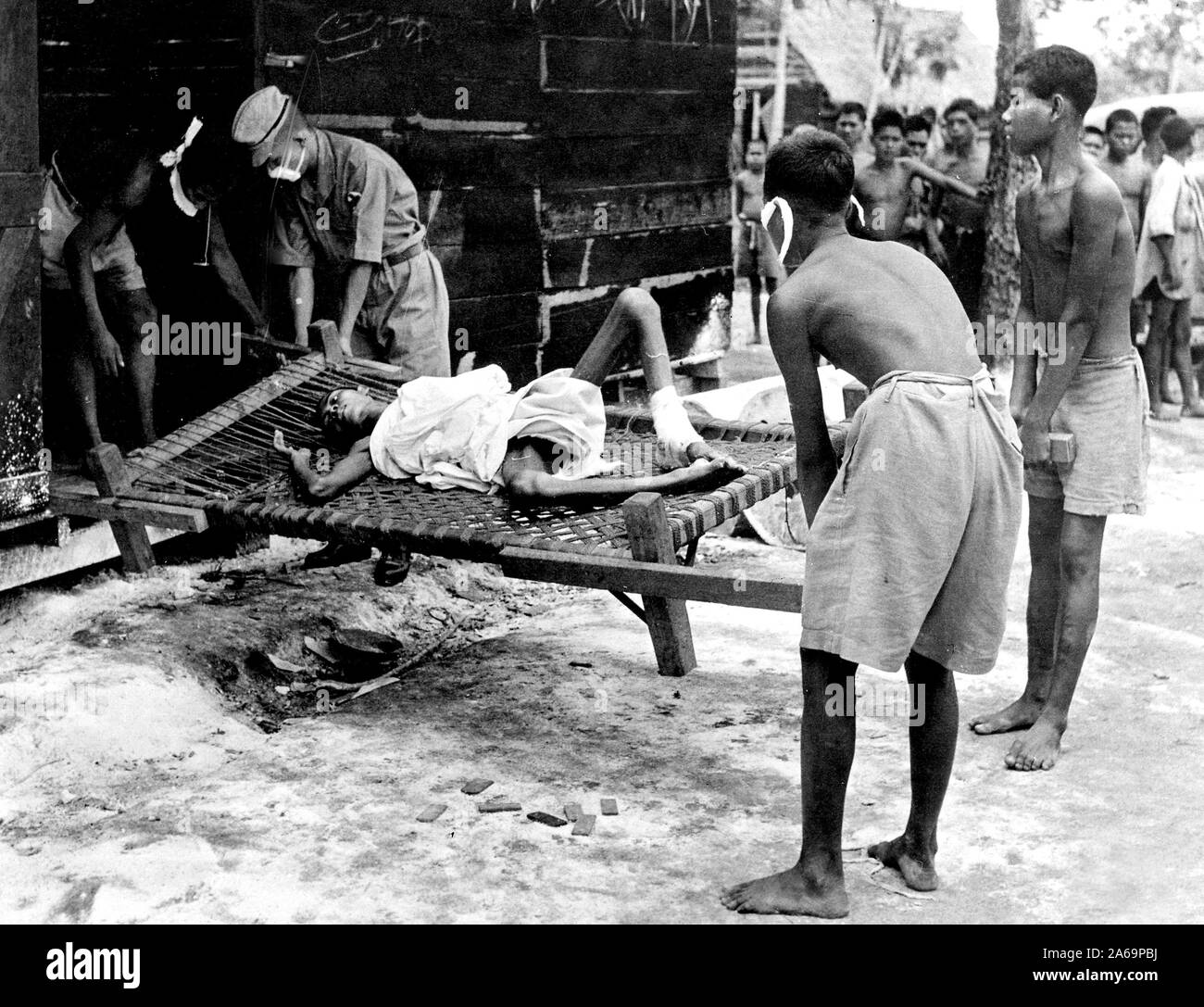 An emaciated coolie too weak to walk is carried on a charpoy by fellow-coolies at the Japanese labor camp at Seletah, in the northern part of Singapore. Populated by about 1700 persons, including Javanese, the camp was discovered by the British accidentally. With their arrival an effort was made to clean up the camp and administer to the sick. Stock Photohttps://www.alamy.com/image-license-details/?v=1https://www.alamy.com/an-emaciated-coolie-too-weak-to-walk-is-carried-on-a-charpoy-by-fellow-coolies-at-the-japanese-labor-camp-at-seletah-in-the-northern-part-of-singapore-populated-by-about-1700-persons-including-javanese-the-camp-was-discovered-by-the-british-accidentally-with-their-arrival-an-effort-was-made-to-clean-up-the-camp-and-administer-to-the-sick-image330900070.html
An emaciated coolie too weak to walk is carried on a charpoy by fellow-coolies at the Japanese labor camp at Seletah, in the northern part of Singapore. Populated by about 1700 persons, including Javanese, the camp was discovered by the British accidentally. With their arrival an effort was made to clean up the camp and administer to the sick. Stock Photohttps://www.alamy.com/image-license-details/?v=1https://www.alamy.com/an-emaciated-coolie-too-weak-to-walk-is-carried-on-a-charpoy-by-fellow-coolies-at-the-japanese-labor-camp-at-seletah-in-the-northern-part-of-singapore-populated-by-about-1700-persons-including-javanese-the-camp-was-discovered-by-the-british-accidentally-with-their-arrival-an-effort-was-made-to-clean-up-the-camp-and-administer-to-the-sick-image330900070.htmlRM2A69PBJ–An emaciated coolie too weak to walk is carried on a charpoy by fellow-coolies at the Japanese labor camp at Seletah, in the northern part of Singapore. Populated by about 1700 persons, including Javanese, the camp was discovered by the British accidentally. With their arrival an effort was made to clean up the camp and administer to the sick.
 Central Tokyo Stock Photohttps://www.alamy.com/image-license-details/?v=1https://www.alamy.com/stock-photo-central-tokyo-36059602.html
Central Tokyo Stock Photohttps://www.alamy.com/image-license-details/?v=1https://www.alamy.com/stock-photo-central-tokyo-36059602.htmlRMC2JJAX–Central Tokyo
 Checkmating meddlers with the Manchurian Railway Line. A Russian Curb on Japanese cunning. A railway patrol of cossacks arresting Japanese suspects disguised as coolies 1904 Stock Photohttps://www.alamy.com/image-license-details/?v=1https://www.alamy.com/checkmating-meddlers-with-the-manchurian-railway-line-a-russian-curb-on-japanese-cunning-a-railway-patrol-of-cossacks-arresting-japanese-suspects-disguised-as-coolies-1904-image623745619.html
Checkmating meddlers with the Manchurian Railway Line. A Russian Curb on Japanese cunning. A railway patrol of cossacks arresting Japanese suspects disguised as coolies 1904 Stock Photohttps://www.alamy.com/image-license-details/?v=1https://www.alamy.com/checkmating-meddlers-with-the-manchurian-railway-line-a-russian-curb-on-japanese-cunning-a-railway-patrol-of-cossacks-arresting-japanese-suspects-disguised-as-coolies-1904-image623745619.htmlRM2Y6P1W7–Checkmating meddlers with the Manchurian Railway Line. A Russian Curb on Japanese cunning. A railway patrol of cossacks arresting Japanese suspects disguised as coolies 1904
 Japanese and Korean coolies removing supplies from wharf of Chemulpo Stock Photohttps://www.alamy.com/image-license-details/?v=1https://www.alamy.com/japanese-and-korean-coolies-removing-supplies-from-wharf-of-chemulpo-image367379253.html
Japanese and Korean coolies removing supplies from wharf of Chemulpo Stock Photohttps://www.alamy.com/image-license-details/?v=1https://www.alamy.com/japanese-and-korean-coolies-removing-supplies-from-wharf-of-chemulpo-image367379253.htmlRM2C9KFYH–Japanese and Korean coolies removing supplies from wharf of Chemulpo
 Japanese and Korean coolies removing supplies from wharf of Chemulpo Stock Photohttps://www.alamy.com/image-license-details/?v=1https://www.alamy.com/japanese-and-korean-coolies-removing-supplies-from-wharf-of-chemulpo-image270071047.html
Japanese and Korean coolies removing supplies from wharf of Chemulpo Stock Photohttps://www.alamy.com/image-license-details/?v=1https://www.alamy.com/japanese-and-korean-coolies-removing-supplies-from-wharf-of-chemulpo-image270071047.htmlRMWKAPAF–Japanese and Korean coolies removing supplies from wharf of Chemulpo
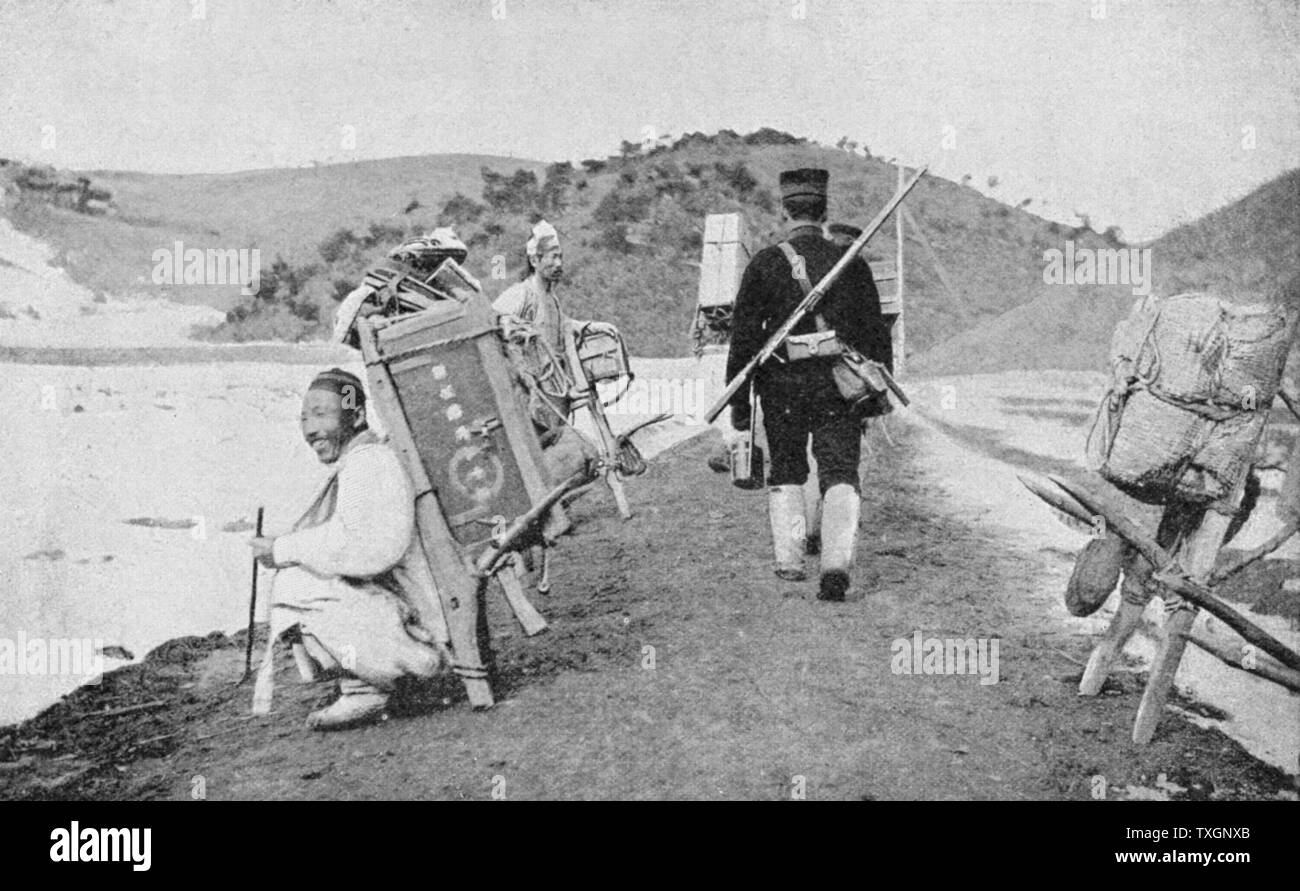 Russo-Japanese War, 1904-1905: Korean coolies acting as porters for Japanese soldiers Stock Photohttps://www.alamy.com/image-license-details/?v=1https://www.alamy.com/russo-japanese-war-1904-1905-korean-coolies-acting-as-porters-for-japanese-soldiers-image257294643.html
Russo-Japanese War, 1904-1905: Korean coolies acting as porters for Japanese soldiers Stock Photohttps://www.alamy.com/image-license-details/?v=1https://www.alamy.com/russo-japanese-war-1904-1905-korean-coolies-acting-as-porters-for-japanese-soldiers-image257294643.htmlRMTXGNXB–Russo-Japanese War, 1904-1905: Korean coolies acting as porters for Japanese soldiers
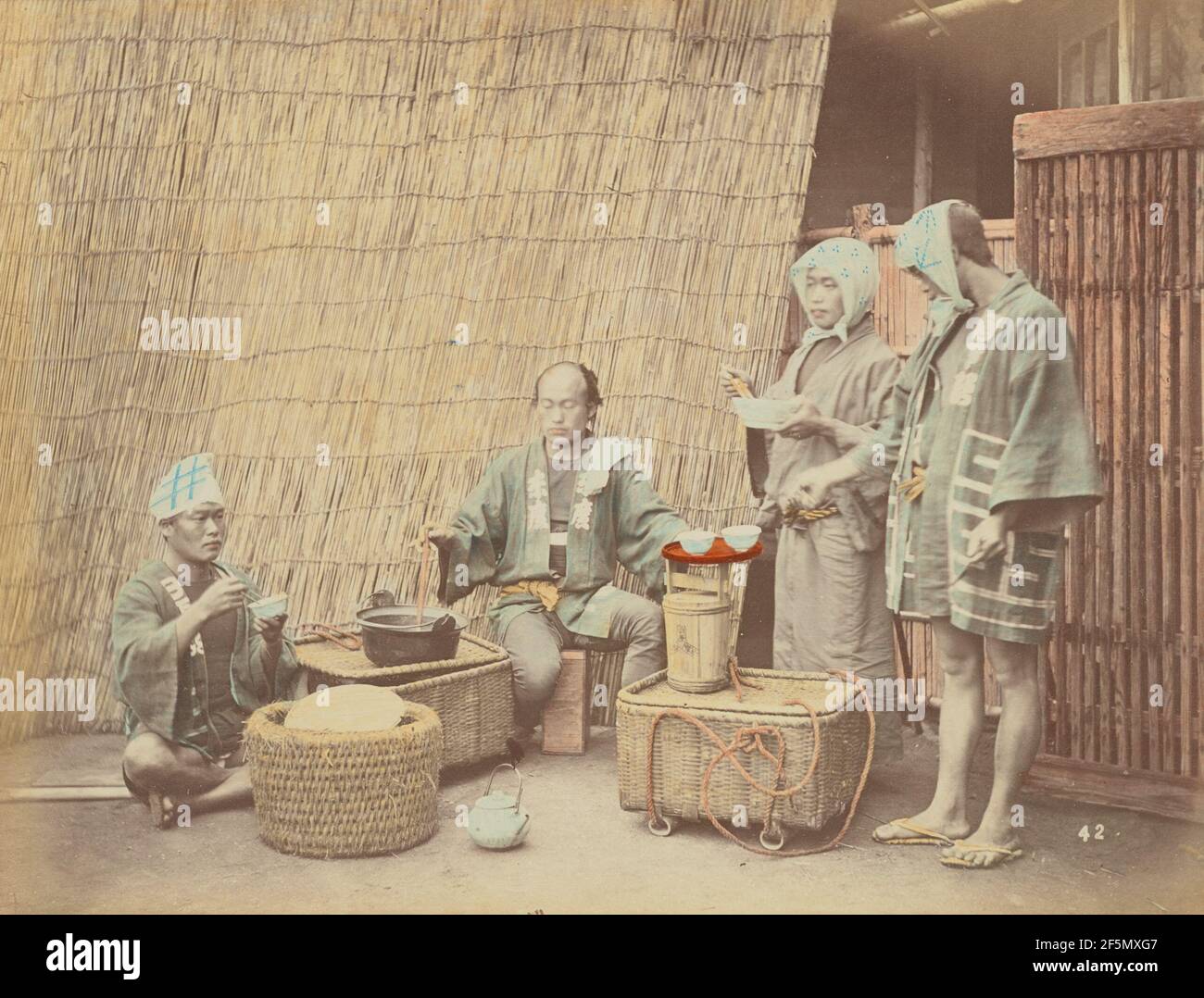 Coolies Wayside Refreshments. Kusakabe Kimbei (Japanese, 1841 - 1934) Stock Photohttps://www.alamy.com/image-license-details/?v=1https://www.alamy.com/coolies-wayside-refreshments-kusakabe-kimbei-japanese-1841-1934-image416581991.html
Coolies Wayside Refreshments. Kusakabe Kimbei (Japanese, 1841 - 1934) Stock Photohttps://www.alamy.com/image-license-details/?v=1https://www.alamy.com/coolies-wayside-refreshments-kusakabe-kimbei-japanese-1841-1934-image416581991.htmlRM2F5MXG7–Coolies Wayside Refreshments. Kusakabe Kimbei (Japanese, 1841 - 1934)
 Japanese and Korean coolies removing supplies from wharf of Chemulpo, c1904. Stock Photohttps://www.alamy.com/image-license-details/?v=1https://www.alamy.com/japanese-and-korean-coolies-removing-supplies-from-wharf-of-chemulpo-c1904-image595014694.html
Japanese and Korean coolies removing supplies from wharf of Chemulpo, c1904. Stock Photohttps://www.alamy.com/image-license-details/?v=1https://www.alamy.com/japanese-and-korean-coolies-removing-supplies-from-wharf-of-chemulpo-c1904-image595014694.htmlRM2WG178P–Japanese and Korean coolies removing supplies from wharf of Chemulpo, c1904.
 Portrait of three unknown Japanese men wearing a mino; Japanese Coolies Wearing Mino. . Stock Photohttps://www.alamy.com/image-license-details/?v=1https://www.alamy.com/portrait-of-three-unknown-japanese-men-wearing-a-mino-japanese-coolies-wearing-mino-image432753131.html
Portrait of three unknown Japanese men wearing a mino; Japanese Coolies Wearing Mino. . Stock Photohttps://www.alamy.com/image-license-details/?v=1https://www.alamy.com/portrait-of-three-unknown-japanese-men-wearing-a-mino-japanese-coolies-wearing-mino-image432753131.htmlRM2G41H0Y–Portrait of three unknown Japanese men wearing a mino; Japanese Coolies Wearing Mino. .
 A Japanese film of Changi showed Australian prisoners working like coolies to haul stripped truck chassis loaded with rails. November 22, 1950 Stock Photohttps://www.alamy.com/image-license-details/?v=1https://www.alamy.com/a-japanese-film-of-changi-showed-australian-prisoners-working-like-coolies-to-haul-stripped-truck-chassis-loaded-with-rails-november-22-1950-image463576780.html
A Japanese film of Changi showed Australian prisoners working like coolies to haul stripped truck chassis loaded with rails. November 22, 1950 Stock Photohttps://www.alamy.com/image-license-details/?v=1https://www.alamy.com/a-japanese-film-of-changi-showed-australian-prisoners-working-like-coolies-to-haul-stripped-truck-chassis-loaded-with-rails-november-22-1950-image463576780.htmlRM2HX5MWG–A Japanese film of Changi showed Australian prisoners working like coolies to haul stripped truck chassis loaded with rails. November 22, 1950
 HONG KONG RE-OCCUPIED. SEPTEMBER 1945, SCENES IN HONG KONG FOLLOWING THE RE-OCCUPATION OF THE CROWN COLONY AFTER THE JAPANESE SURRENDER. - Chinese coolies having their passes checked before being employed in Hong Kong dockyard. They still have the passes issued to them before the Japanese invasion. , Stock Photohttps://www.alamy.com/image-license-details/?v=1https://www.alamy.com/hong-kong-re-occupied-september-1945-scenes-in-hong-kong-following-the-re-occupation-of-the-crown-colony-after-the-japanese-surrender-chinese-coolies-having-their-passes-checked-before-being-employed-in-hong-kong-dockyard-they-still-have-the-passes-issued-to-them-before-the-japanese-invasion-image601996522.html
HONG KONG RE-OCCUPIED. SEPTEMBER 1945, SCENES IN HONG KONG FOLLOWING THE RE-OCCUPATION OF THE CROWN COLONY AFTER THE JAPANESE SURRENDER. - Chinese coolies having their passes checked before being employed in Hong Kong dockyard. They still have the passes issued to them before the Japanese invasion. , Stock Photohttps://www.alamy.com/image-license-details/?v=1https://www.alamy.com/hong-kong-re-occupied-september-1945-scenes-in-hong-kong-following-the-re-occupation-of-the-crown-colony-after-the-japanese-surrender-chinese-coolies-having-their-passes-checked-before-being-employed-in-hong-kong-dockyard-they-still-have-the-passes-issued-to-them-before-the-japanese-invasion-image601996522.htmlRM2WYB8KP–HONG KONG RE-OCCUPIED. SEPTEMBER 1945, SCENES IN HONG KONG FOLLOWING THE RE-OCCUPATION OF THE CROWN COLONY AFTER THE JAPANESE SURRENDER. - Chinese coolies having their passes checked before being employed in Hong Kong dockyard. They still have the passes issued to them before the Japanese invasion. ,
![[ 1880s Japan - Gambling Coolies ] — Laborers gambling outside on a straw mat. A dice and lots of coins can be seen. 19th century vintage albumen photograph. Stock Photo [ 1880s Japan - Gambling Coolies ] — Laborers gambling outside on a straw mat. A dice and lots of coins can be seen. 19th century vintage albumen photograph. Stock Photo](https://c8.alamy.com/comp/2BN0JWD/1880s-japan-gambling-coolies-laborers-gambling-outside-on-a-straw-mat-a-dice-and-lots-of-coins-can-be-seen-19th-century-vintage-albumen-photograph-2BN0JWD.jpg) [ 1880s Japan - Gambling Coolies ] — Laborers gambling outside on a straw mat. A dice and lots of coins can be seen. 19th century vintage albumen photograph. Stock Photohttps://www.alamy.com/image-license-details/?v=1https://www.alamy.com/1880s-japan-gambling-coolies-laborers-gambling-outside-on-a-straw-mat-a-dice-and-lots-of-coins-can-be-seen-19th-century-vintage-albumen-photograph-image357129961.html
[ 1880s Japan - Gambling Coolies ] — Laborers gambling outside on a straw mat. A dice and lots of coins can be seen. 19th century vintage albumen photograph. Stock Photohttps://www.alamy.com/image-license-details/?v=1https://www.alamy.com/1880s-japan-gambling-coolies-laborers-gambling-outside-on-a-straw-mat-a-dice-and-lots-of-coins-can-be-seen-19th-century-vintage-albumen-photograph-image357129961.htmlRM2BN0JWD–[ 1880s Japan - Gambling Coolies ] — Laborers gambling outside on a straw mat. A dice and lots of coins can be seen. 19th century vintage albumen photograph.
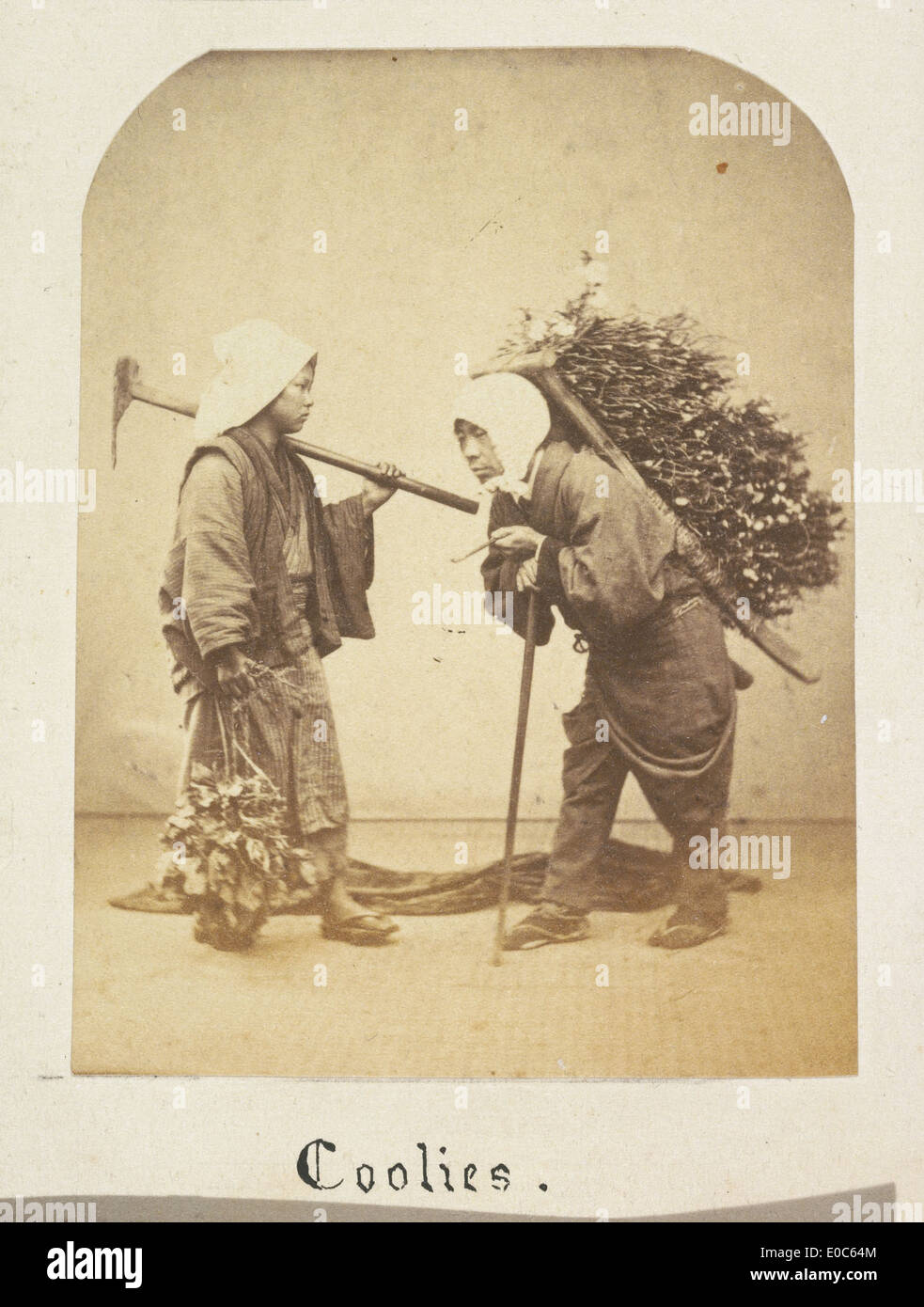 Japanese labourers Stock Photohttps://www.alamy.com/image-license-details/?v=1https://www.alamy.com/japanese-labourers-image69109732.html
Japanese labourers Stock Photohttps://www.alamy.com/image-license-details/?v=1https://www.alamy.com/japanese-labourers-image69109732.htmlRME0C64M–Japanese labourers
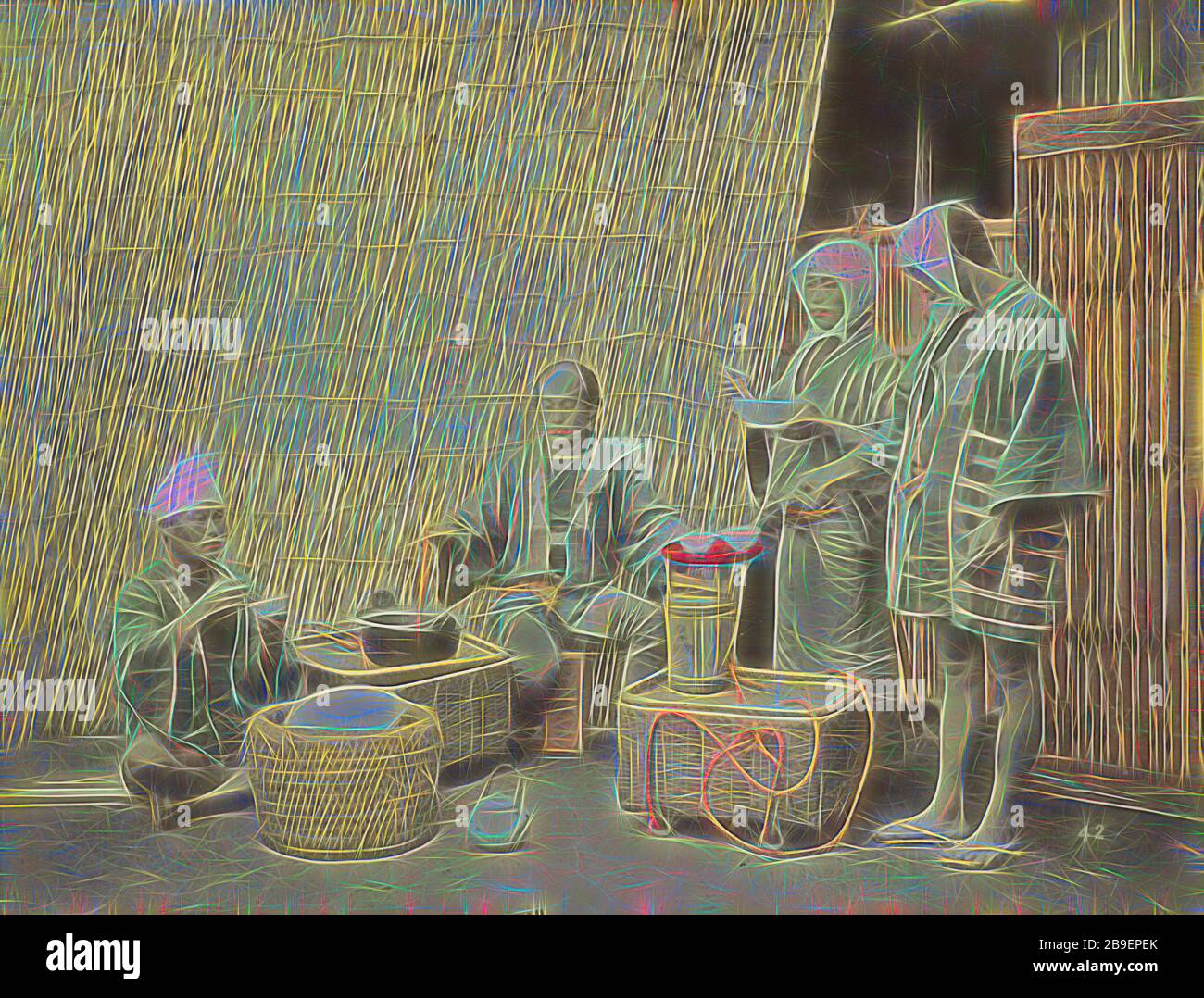 Coolies Wayside Refreshments, Kusakabe Kimbei (Japanese, 1841 - 1934, active 1880s - about 1912), Japan, 1870s - 1890s, Hand-colored Albumen silver print, Reimagined by Gibon, design of warm cheerful glowing of brightness and light rays radiance. Classic art reinvented with a modern twist. Photography inspired by futurism, embracing dynamic energy of modern technology, movement, speed and revolutionize culture. Stock Photohttps://www.alamy.com/image-license-details/?v=1https://www.alamy.com/coolies-wayside-refreshments-kusakabe-kimbei-japanese-1841-1934-active-1880s-about-1912-japan-1870s-1890s-hand-colored-albumen-silver-print-reimagined-by-gibon-design-of-warm-cheerful-glowing-of-brightness-and-light-rays-radiance-classic-art-reinvented-with-a-modern-twist-photography-inspired-by-futurism-embracing-dynamic-energy-of-modern-technology-movement-speed-and-revolutionize-culture-image350064251.html
Coolies Wayside Refreshments, Kusakabe Kimbei (Japanese, 1841 - 1934, active 1880s - about 1912), Japan, 1870s - 1890s, Hand-colored Albumen silver print, Reimagined by Gibon, design of warm cheerful glowing of brightness and light rays radiance. Classic art reinvented with a modern twist. Photography inspired by futurism, embracing dynamic energy of modern technology, movement, speed and revolutionize culture. Stock Photohttps://www.alamy.com/image-license-details/?v=1https://www.alamy.com/coolies-wayside-refreshments-kusakabe-kimbei-japanese-1841-1934-active-1880s-about-1912-japan-1870s-1890s-hand-colored-albumen-silver-print-reimagined-by-gibon-design-of-warm-cheerful-glowing-of-brightness-and-light-rays-radiance-classic-art-reinvented-with-a-modern-twist-photography-inspired-by-futurism-embracing-dynamic-energy-of-modern-technology-movement-speed-and-revolutionize-culture-image350064251.htmlRF2B9EPEK–Coolies Wayside Refreshments, Kusakabe Kimbei (Japanese, 1841 - 1934, active 1880s - about 1912), Japan, 1870s - 1890s, Hand-colored Albumen silver print, Reimagined by Gibon, design of warm cheerful glowing of brightness and light rays radiance. Classic art reinvented with a modern twist. Photography inspired by futurism, embracing dynamic energy of modern technology, movement, speed and revolutionize culture.
 Coolies, street scene in Tokyo, 1896. Artist: Underwood & Underwood Stock Photohttps://www.alamy.com/image-license-details/?v=1https://www.alamy.com/stock-photo-coolies-street-scene-in-tokyo-1896-artist-underwood-underwood-24618804.html
Coolies, street scene in Tokyo, 1896. Artist: Underwood & Underwood Stock Photohttps://www.alamy.com/image-license-details/?v=1https://www.alamy.com/stock-photo-coolies-street-scene-in-tokyo-1896-artist-underwood-underwood-24618804.htmlRMBC1DF0–Coolies, street scene in Tokyo, 1896. Artist: Underwood & Underwood
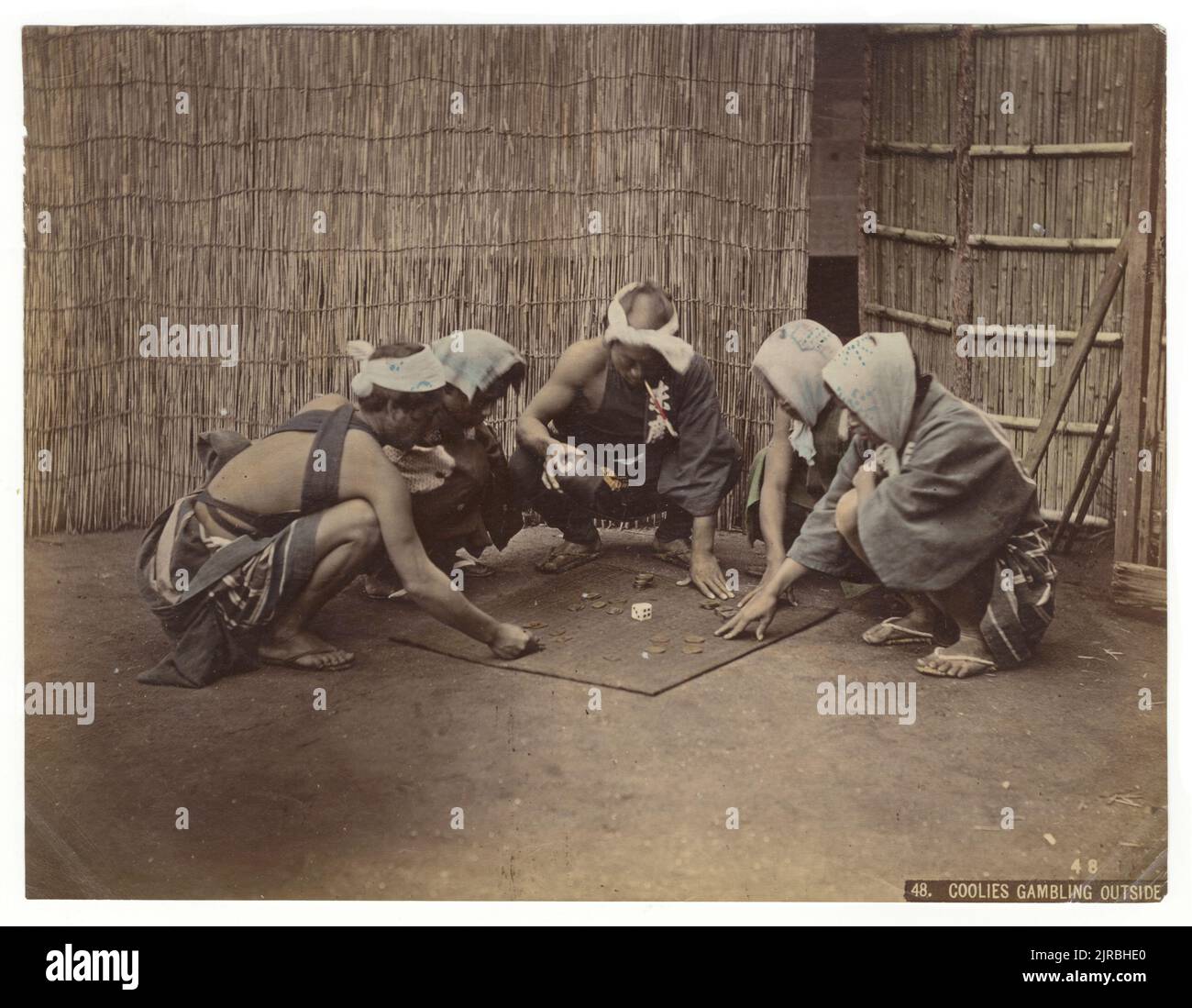 Coolies Gambling Outside, Japan, circa 1890. Photography by Kusakabe Kimbei (1841 - 1934). Stock Photohttps://www.alamy.com/image-license-details/?v=1https://www.alamy.com/coolies-gambling-outside-japan-circa-1890-photography-by-kusakabe-kimbei-1841-1934-image479072216.html
Coolies Gambling Outside, Japan, circa 1890. Photography by Kusakabe Kimbei (1841 - 1934). Stock Photohttps://www.alamy.com/image-license-details/?v=1https://www.alamy.com/coolies-gambling-outside-japan-circa-1890-photography-by-kusakabe-kimbei-1841-1934-image479072216.htmlRM2JRBHE0–Coolies Gambling Outside, Japan, circa 1890. Photography by Kusakabe Kimbei (1841 - 1934).
 JAPAN. Japan. Tattooing, Japan; mark of low breeding and vulgarity in Japan 1900 Stock Photohttps://www.alamy.com/image-license-details/?v=1https://www.alamy.com/japan-japan-tattooing-japan-mark-of-low-breeding-and-vulgarity-in-japan-1900-image183032086.html
JAPAN. Japan. Tattooing, Japan; mark of low breeding and vulgarity in Japan 1900 Stock Photohttps://www.alamy.com/image-license-details/?v=1https://www.alamy.com/japan-japan-tattooing-japan-mark-of-low-breeding-and-vulgarity-in-japan-1900-image183032086.htmlRFMHNR86–JAPAN. Japan. Tattooing, Japan; mark of low breeding and vulgarity in Japan 1900
 Hodogaya: A bridge over a stream, and across it two coolies are carrying a closed kago towards a village on the opposite bank; behind the village rises a low wooden hill. At this countryside station the travellers had covered a distance of 34 km from Edo and were well into the mood of travelling. By the bridge stands a restaurant which serves Soba (buckwheat noodle) and waitresses stand in front beckoning travellers to the restaurant. Utagawa Hiroshige (歌川 広重, 1797 – October 12, 1858) was a Japanese ukiyo-e artist, and one of the last great artists in that tradition. He was also referred to Stock Photohttps://www.alamy.com/image-license-details/?v=1https://www.alamy.com/hodogaya-a-bridge-over-a-stream-and-across-it-two-coolies-are-carrying-a-closed-kago-towards-a-village-on-the-opposite-bank-behind-the-village-rises-a-low-wooden-hill-at-this-countryside-station-the-travellers-had-covered-a-distance-of-34-km-from-edo-and-were-well-into-the-mood-of-travelling-by-the-bridge-stands-a-restaurant-which-serves-soba-buckwheat-noodle-and-waitresses-stand-in-front-beckoning-travellers-to-the-restaurant-utagawa-hiroshige-1797-october-12-1858-was-a-japanese-ukiyo-e-artist-and-one-of-the-last-great-artists-in-that-tradition-he-was-also-referred-to-image344252416.html
Hodogaya: A bridge over a stream, and across it two coolies are carrying a closed kago towards a village on the opposite bank; behind the village rises a low wooden hill. At this countryside station the travellers had covered a distance of 34 km from Edo and were well into the mood of travelling. By the bridge stands a restaurant which serves Soba (buckwheat noodle) and waitresses stand in front beckoning travellers to the restaurant. Utagawa Hiroshige (歌川 広重, 1797 – October 12, 1858) was a Japanese ukiyo-e artist, and one of the last great artists in that tradition. He was also referred to Stock Photohttps://www.alamy.com/image-license-details/?v=1https://www.alamy.com/hodogaya-a-bridge-over-a-stream-and-across-it-two-coolies-are-carrying-a-closed-kago-towards-a-village-on-the-opposite-bank-behind-the-village-rises-a-low-wooden-hill-at-this-countryside-station-the-travellers-had-covered-a-distance-of-34-km-from-edo-and-were-well-into-the-mood-of-travelling-by-the-bridge-stands-a-restaurant-which-serves-soba-buckwheat-noodle-and-waitresses-stand-in-front-beckoning-travellers-to-the-restaurant-utagawa-hiroshige-1797-october-12-1858-was-a-japanese-ukiyo-e-artist-and-one-of-the-last-great-artists-in-that-tradition-he-was-also-referred-to-image344252416.htmlRM2B021D4–Hodogaya: A bridge over a stream, and across it two coolies are carrying a closed kago towards a village on the opposite bank; behind the village rises a low wooden hill. At this countryside station the travellers had covered a distance of 34 km from Edo and were well into the mood of travelling. By the bridge stands a restaurant which serves Soba (buckwheat noodle) and waitresses stand in front beckoning travellers to the restaurant. Utagawa Hiroshige (歌川 広重, 1797 – October 12, 1858) was a Japanese ukiyo-e artist, and one of the last great artists in that tradition. He was also referred to
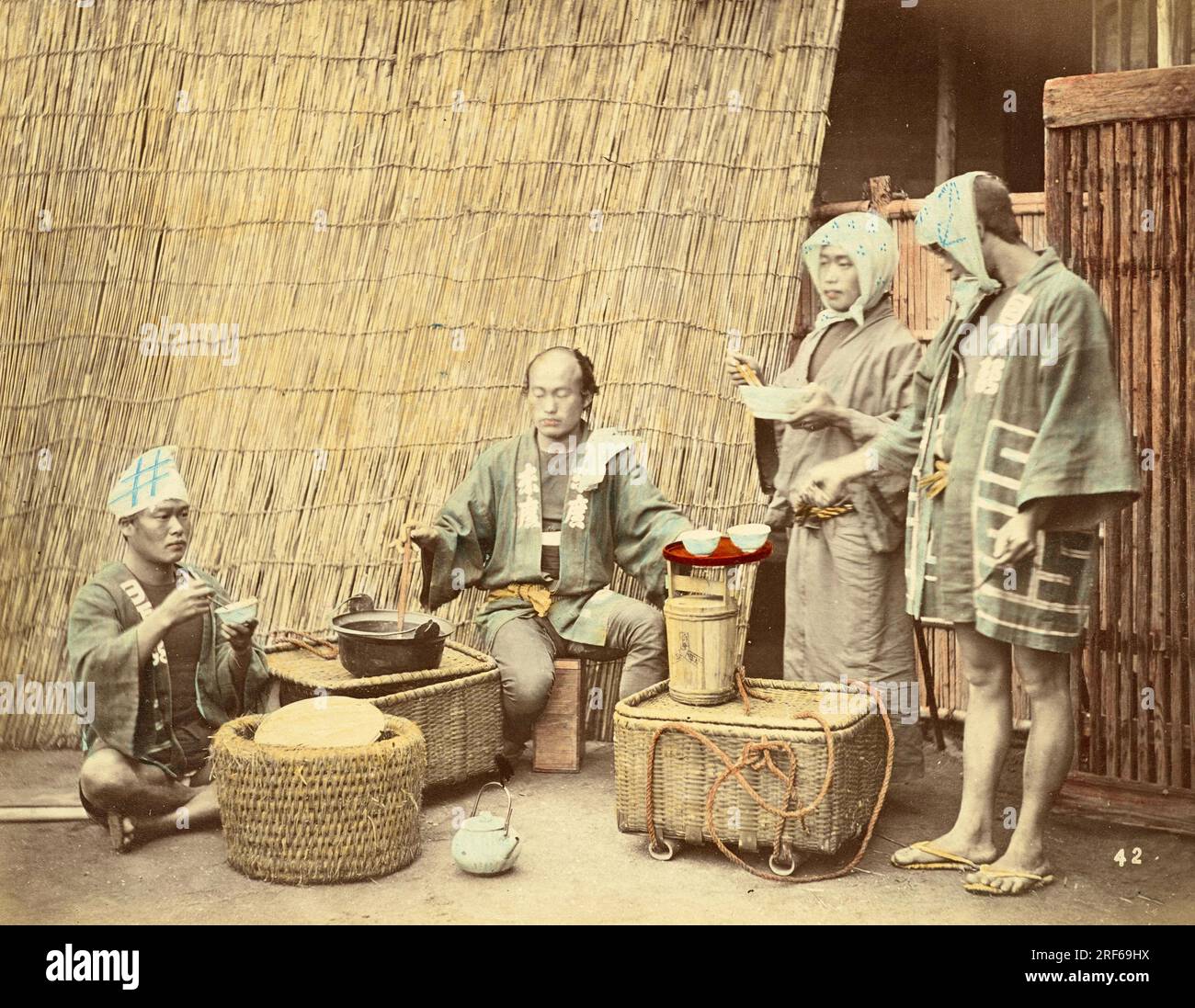 Antikes Japan, Verkauf von Tee, Erfrischungen und Speisen am Wegesrand, um 1880, Japan, Historisch, digital restaurierte Reproduktion von einer Vorlage aus der damaligen Zeit / Ancient Japan, Selling tea, refreshments and food by the wayside, c. 1880, Japan, Historic, digitally restored reproduction from an original of the period. Stock Photohttps://www.alamy.com/image-license-details/?v=1https://www.alamy.com/antikes-japan-verkauf-von-tee-erfrischungen-und-speisen-am-wegesrand-um-1880-japan-historisch-digital-restaurierte-reproduktion-von-einer-vorlage-aus-der-damaligen-zeit-ancient-japan-selling-tea-refreshments-and-food-by-the-wayside-c-1880-japan-historic-digitally-restored-reproduction-from-an-original-of-the-period-image560090886.html
Antikes Japan, Verkauf von Tee, Erfrischungen und Speisen am Wegesrand, um 1880, Japan, Historisch, digital restaurierte Reproduktion von einer Vorlage aus der damaligen Zeit / Ancient Japan, Selling tea, refreshments and food by the wayside, c. 1880, Japan, Historic, digitally restored reproduction from an original of the period. Stock Photohttps://www.alamy.com/image-license-details/?v=1https://www.alamy.com/antikes-japan-verkauf-von-tee-erfrischungen-und-speisen-am-wegesrand-um-1880-japan-historisch-digital-restaurierte-reproduktion-von-einer-vorlage-aus-der-damaligen-zeit-ancient-japan-selling-tea-refreshments-and-food-by-the-wayside-c-1880-japan-historic-digitally-restored-reproduction-from-an-original-of-the-period-image560090886.htmlRF2RF69HX–Antikes Japan, Verkauf von Tee, Erfrischungen und Speisen am Wegesrand, um 1880, Japan, Historisch, digital restaurierte Reproduktion von einer Vorlage aus der damaligen Zeit / Ancient Japan, Selling tea, refreshments and food by the wayside, c. 1880, Japan, Historic, digitally restored reproduction from an original of the period.
 Fujieda: Changing horses and coolies outside a resthouse. A lively scene of a relay operation taking place under the supervision of the station officials. An official of lower rank enters porterage fares in a record book. Utagawa Hiroshige (歌川 広重, 1797 – October 12, 1858) was a Japanese ukiyo-e artist, and one of the last great artists in that tradition. He was also referred to as Andō Hiroshige (安藤 広重) (an irregular combination of family name and art name) and by the art name of Ichiyūsai Hiroshige (一幽斎廣重). The Tōkaidō (東海道 East Sea Road) was the most important of the Five Routes of the Edo Stock Photohttps://www.alamy.com/image-license-details/?v=1https://www.alamy.com/fujieda-changing-horses-and-coolies-outside-a-resthouse-a-lively-scene-of-a-relay-operation-taking-place-under-the-supervision-of-the-station-officials-an-official-of-lower-rank-enters-porterage-fares-in-a-record-book-utagawa-hiroshige-1797-october-12-1858-was-a-japanese-ukiyo-e-artist-and-one-of-the-last-great-artists-in-that-tradition-he-was-also-referred-to-as-and-hiroshige-an-irregular-combination-of-family-name-and-art-name-and-by-the-art-name-of-ichiysai-hiroshige-the-tkaid-east-sea-road-was-the-most-important-of-the-five-routes-of-the-edo-image344252445.html
Fujieda: Changing horses and coolies outside a resthouse. A lively scene of a relay operation taking place under the supervision of the station officials. An official of lower rank enters porterage fares in a record book. Utagawa Hiroshige (歌川 広重, 1797 – October 12, 1858) was a Japanese ukiyo-e artist, and one of the last great artists in that tradition. He was also referred to as Andō Hiroshige (安藤 広重) (an irregular combination of family name and art name) and by the art name of Ichiyūsai Hiroshige (一幽斎廣重). The Tōkaidō (東海道 East Sea Road) was the most important of the Five Routes of the Edo Stock Photohttps://www.alamy.com/image-license-details/?v=1https://www.alamy.com/fujieda-changing-horses-and-coolies-outside-a-resthouse-a-lively-scene-of-a-relay-operation-taking-place-under-the-supervision-of-the-station-officials-an-official-of-lower-rank-enters-porterage-fares-in-a-record-book-utagawa-hiroshige-1797-october-12-1858-was-a-japanese-ukiyo-e-artist-and-one-of-the-last-great-artists-in-that-tradition-he-was-also-referred-to-as-and-hiroshige-an-irregular-combination-of-family-name-and-art-name-and-by-the-art-name-of-ichiysai-hiroshige-the-tkaid-east-sea-road-was-the-most-important-of-the-five-routes-of-the-edo-image344252445.htmlRM2B021E5–Fujieda: Changing horses and coolies outside a resthouse. A lively scene of a relay operation taking place under the supervision of the station officials. An official of lower rank enters porterage fares in a record book. Utagawa Hiroshige (歌川 広重, 1797 – October 12, 1858) was a Japanese ukiyo-e artist, and one of the last great artists in that tradition. He was also referred to as Andō Hiroshige (安藤 広重) (an irregular combination of family name and art name) and by the art name of Ichiyūsai Hiroshige (一幽斎廣重). The Tōkaidō (東海道 East Sea Road) was the most important of the Five Routes of the Edo
 Ginza, the business end of Nihonbashi street, principal street of Tokyo, Japan Stock Photohttps://www.alamy.com/image-license-details/?v=1https://www.alamy.com/stock-photo-ginza-the-business-end-of-nihonbashi-street-principal-street-of-tokyo-36059600.html
Ginza, the business end of Nihonbashi street, principal street of Tokyo, Japan Stock Photohttps://www.alamy.com/image-license-details/?v=1https://www.alamy.com/stock-photo-ginza-the-business-end-of-nihonbashi-street-principal-street-of-tokyo-36059600.htmlRMC2JJAT–Ginza, the business end of Nihonbashi street, principal street of Tokyo, Japan
 Sleeping quarters in a Japanese labor camp at Seletah, in the northern part of Singapore, are in thatched houses raised above the ground for protection against insects and reptiles. About 1700 coolies, many from Java, were brought here, assigned to enforced labor, and forced to live in filth and squalor until a British naval party accidentally found them. Stock Photohttps://www.alamy.com/image-license-details/?v=1https://www.alamy.com/sleeping-quarters-in-a-japanese-labor-camp-at-seletah-in-the-northern-part-of-singapore-are-in-thatched-houses-raised-above-the-ground-for-protection-against-insects-and-reptiles-about-1700-coolies-many-from-java-were-brought-here-assigned-to-enforced-labor-and-forced-to-live-in-filth-and-squalor-until-a-british-naval-party-accidentally-found-them-image330900062.html
Sleeping quarters in a Japanese labor camp at Seletah, in the northern part of Singapore, are in thatched houses raised above the ground for protection against insects and reptiles. About 1700 coolies, many from Java, were brought here, assigned to enforced labor, and forced to live in filth and squalor until a British naval party accidentally found them. Stock Photohttps://www.alamy.com/image-license-details/?v=1https://www.alamy.com/sleeping-quarters-in-a-japanese-labor-camp-at-seletah-in-the-northern-part-of-singapore-are-in-thatched-houses-raised-above-the-ground-for-protection-against-insects-and-reptiles-about-1700-coolies-many-from-java-were-brought-here-assigned-to-enforced-labor-and-forced-to-live-in-filth-and-squalor-until-a-british-naval-party-accidentally-found-them-image330900062.htmlRM2A69PBA–Sleeping quarters in a Japanese labor camp at Seletah, in the northern part of Singapore, are in thatched houses raised above the ground for protection against insects and reptiles. About 1700 coolies, many from Java, were brought here, assigned to enforced labor, and forced to live in filth and squalor until a British naval party accidentally found them.
 Sinews of War. Stores For The Japanese Armies In The Field. The light hand cart of the Japanese transport hurrying field stores to the troop trains at Toyko 16 February 1904 Stock Photohttps://www.alamy.com/image-license-details/?v=1https://www.alamy.com/sinews-of-war-stores-for-the-japanese-armies-in-the-field-the-light-hand-cart-of-the-japanese-transport-hurrying-field-stores-to-the-troop-trains-at-toyko-16-february-1904-image623745601.html
Sinews of War. Stores For The Japanese Armies In The Field. The light hand cart of the Japanese transport hurrying field stores to the troop trains at Toyko 16 February 1904 Stock Photohttps://www.alamy.com/image-license-details/?v=1https://www.alamy.com/sinews-of-war-stores-for-the-japanese-armies-in-the-field-the-light-hand-cart-of-the-japanese-transport-hurrying-field-stores-to-the-troop-trains-at-toyko-16-february-1904-image623745601.htmlRM2Y6P1TH–Sinews of War. Stores For The Japanese Armies In The Field. The light hand cart of the Japanese transport hurrying field stores to the troop trains at Toyko 16 February 1904
 A crowd of Japanese soldiers; Chinese coolies in right foreground, Manchuria Stock Photohttps://www.alamy.com/image-license-details/?v=1https://www.alamy.com/a-crowd-of-japanese-soldiers-chinese-coolies-in-right-foreground-manchuria-image263252199.html
A crowd of Japanese soldiers; Chinese coolies in right foreground, Manchuria Stock Photohttps://www.alamy.com/image-license-details/?v=1https://www.alamy.com/a-crowd-of-japanese-soldiers-chinese-coolies-in-right-foreground-manchuria-image263252199.htmlRMW884T7–A crowd of Japanese soldiers; Chinese coolies in right foreground, Manchuria
 Russo-Japanese War 1904-1905 : Japanese and Korean coolies removing supplies from the wharf at Chemulpo, Korea Stock Photohttps://www.alamy.com/image-license-details/?v=1https://www.alamy.com/russo-japanese-war-1904-1905-japanese-and-korean-coolies-removing-supplies-from-the-wharf-at-chemulpo-korea-image257283602.html
Russo-Japanese War 1904-1905 : Japanese and Korean coolies removing supplies from the wharf at Chemulpo, Korea Stock Photohttps://www.alamy.com/image-license-details/?v=1https://www.alamy.com/russo-japanese-war-1904-1905-japanese-and-korean-coolies-removing-supplies-from-the-wharf-at-chemulpo-korea-image257283602.htmlRMTXG7T2–Russo-Japanese War 1904-1905 : Japanese and Korean coolies removing supplies from the wharf at Chemulpo, Korea
 Fukuroi: Coolies resting by a wayside shelter, while a large kettle, hung from the branch of a tree, is boiling; a woman stirs the fire, while a coolie lights his pipe at it. Close against the tree stands a road direction post, and on the right is a bird perched upon a wayside noticeboard; behind are rice fields, at the edge of which stands the village. In this vicinity the highway passed through desolate fields and it was uncomfortable to journey along during the summer months. However, this district was renowned for its strong winds in winter when kite flying was a popular local pastime. U Stock Photohttps://www.alamy.com/image-license-details/?v=1https://www.alamy.com/fukuroi-coolies-resting-by-a-wayside-shelter-while-a-large-kettle-hung-from-the-branch-of-a-tree-is-boiling-a-woman-stirs-the-fire-while-a-coolie-lights-his-pipe-at-it-close-against-the-tree-stands-a-road-direction-post-and-on-the-right-is-a-bird-perched-upon-a-wayside-noticeboard-behind-are-rice-fields-at-the-edge-of-which-stands-the-village-in-this-vicinity-the-highway-passed-through-desolate-fields-and-it-was-uncomfortable-to-journey-along-during-the-summer-months-however-this-district-was-renowned-for-its-strong-winds-in-winter-when-kite-flying-was-a-popular-local-pastime-u-image344252502.html
Fukuroi: Coolies resting by a wayside shelter, while a large kettle, hung from the branch of a tree, is boiling; a woman stirs the fire, while a coolie lights his pipe at it. Close against the tree stands a road direction post, and on the right is a bird perched upon a wayside noticeboard; behind are rice fields, at the edge of which stands the village. In this vicinity the highway passed through desolate fields and it was uncomfortable to journey along during the summer months. However, this district was renowned for its strong winds in winter when kite flying was a popular local pastime. U Stock Photohttps://www.alamy.com/image-license-details/?v=1https://www.alamy.com/fukuroi-coolies-resting-by-a-wayside-shelter-while-a-large-kettle-hung-from-the-branch-of-a-tree-is-boiling-a-woman-stirs-the-fire-while-a-coolie-lights-his-pipe-at-it-close-against-the-tree-stands-a-road-direction-post-and-on-the-right-is-a-bird-perched-upon-a-wayside-noticeboard-behind-are-rice-fields-at-the-edge-of-which-stands-the-village-in-this-vicinity-the-highway-passed-through-desolate-fields-and-it-was-uncomfortable-to-journey-along-during-the-summer-months-however-this-district-was-renowned-for-its-strong-winds-in-winter-when-kite-flying-was-a-popular-local-pastime-u-image344252502.htmlRM2B021G6–Fukuroi: Coolies resting by a wayside shelter, while a large kettle, hung from the branch of a tree, is boiling; a woman stirs the fire, while a coolie lights his pipe at it. Close against the tree stands a road direction post, and on the right is a bird perched upon a wayside noticeboard; behind are rice fields, at the edge of which stands the village. In this vicinity the highway passed through desolate fields and it was uncomfortable to journey along during the summer months. However, this district was renowned for its strong winds in winter when kite flying was a popular local pastime. U
 A crowd of Japanese soldiers; Chinese coolies in right foreground, Manchuria, c1905. Stock Photohttps://www.alamy.com/image-license-details/?v=1https://www.alamy.com/a-crowd-of-japanese-soldiers-chinese-coolies-in-right-foreground-manchuria-c1905-image595015038.html
A crowd of Japanese soldiers; Chinese coolies in right foreground, Manchuria, c1905. Stock Photohttps://www.alamy.com/image-license-details/?v=1https://www.alamy.com/a-crowd-of-japanese-soldiers-chinese-coolies-in-right-foreground-manchuria-c1905-image595015038.htmlRM2WG17N2–A crowd of Japanese soldiers; Chinese coolies in right foreground, Manchuria, c1905.
 'Rice power' builds wall around French concession at Shanghai, primitive pile-driver used by modern engineers. Primitive method of pile driving, many hundreds of years old, is being used on the construction by the French of a brick wall to protect the French concession along the boundary with Nantao and Siccawei at Shanghai. The 'rice power' pile driver, as it is called, consist of a heavy stone, which is pulled up by coolies tugging in unison to an ancient chant. When it had been pulled up, the stone is allowed to fall on the pile. Photo shows, the massive stone of the 'rice power'pile driver Stock Photohttps://www.alamy.com/image-license-details/?v=1https://www.alamy.com/rice-power-builds-wall-around-french-concession-at-shanghai-primitive-pile-driver-used-by-modern-engineers-primitive-method-of-pile-driving-many-hundreds-of-years-old-is-being-used-on-the-construction-by-the-french-of-a-brick-wall-to-protect-the-french-concession-along-the-boundary-with-nantao-and-siccawei-at-shanghai-the-rice-power-pile-driver-as-it-is-called-consist-of-a-heavy-stone-which-is-pulled-up-by-coolies-tugging-in-unison-to-an-ancient-chant-when-it-had-been-pulled-up-the-stone-is-allowed-to-fall-on-the-pile-photo-shows-the-massive-stone-of-the-rice-powerpile-driver-image359625848.html
'Rice power' builds wall around French concession at Shanghai, primitive pile-driver used by modern engineers. Primitive method of pile driving, many hundreds of years old, is being used on the construction by the French of a brick wall to protect the French concession along the boundary with Nantao and Siccawei at Shanghai. The 'rice power' pile driver, as it is called, consist of a heavy stone, which is pulled up by coolies tugging in unison to an ancient chant. When it had been pulled up, the stone is allowed to fall on the pile. Photo shows, the massive stone of the 'rice power'pile driver Stock Photohttps://www.alamy.com/image-license-details/?v=1https://www.alamy.com/rice-power-builds-wall-around-french-concession-at-shanghai-primitive-pile-driver-used-by-modern-engineers-primitive-method-of-pile-driving-many-hundreds-of-years-old-is-being-used-on-the-construction-by-the-french-of-a-brick-wall-to-protect-the-french-concession-along-the-boundary-with-nantao-and-siccawei-at-shanghai-the-rice-power-pile-driver-as-it-is-called-consist-of-a-heavy-stone-which-is-pulled-up-by-coolies-tugging-in-unison-to-an-ancient-chant-when-it-had-been-pulled-up-the-stone-is-allowed-to-fall-on-the-pile-photo-shows-the-massive-stone-of-the-rice-powerpile-driver-image359625848.htmlRM2BW2AC8–'Rice power' builds wall around French concession at Shanghai, primitive pile-driver used by modern engineers. Primitive method of pile driving, many hundreds of years old, is being used on the construction by the French of a brick wall to protect the French concession along the boundary with Nantao and Siccawei at Shanghai. The 'rice power' pile driver, as it is called, consist of a heavy stone, which is pulled up by coolies tugging in unison to an ancient chant. When it had been pulled up, the stone is allowed to fall on the pile. Photo shows, the massive stone of the 'rice power'pile driver
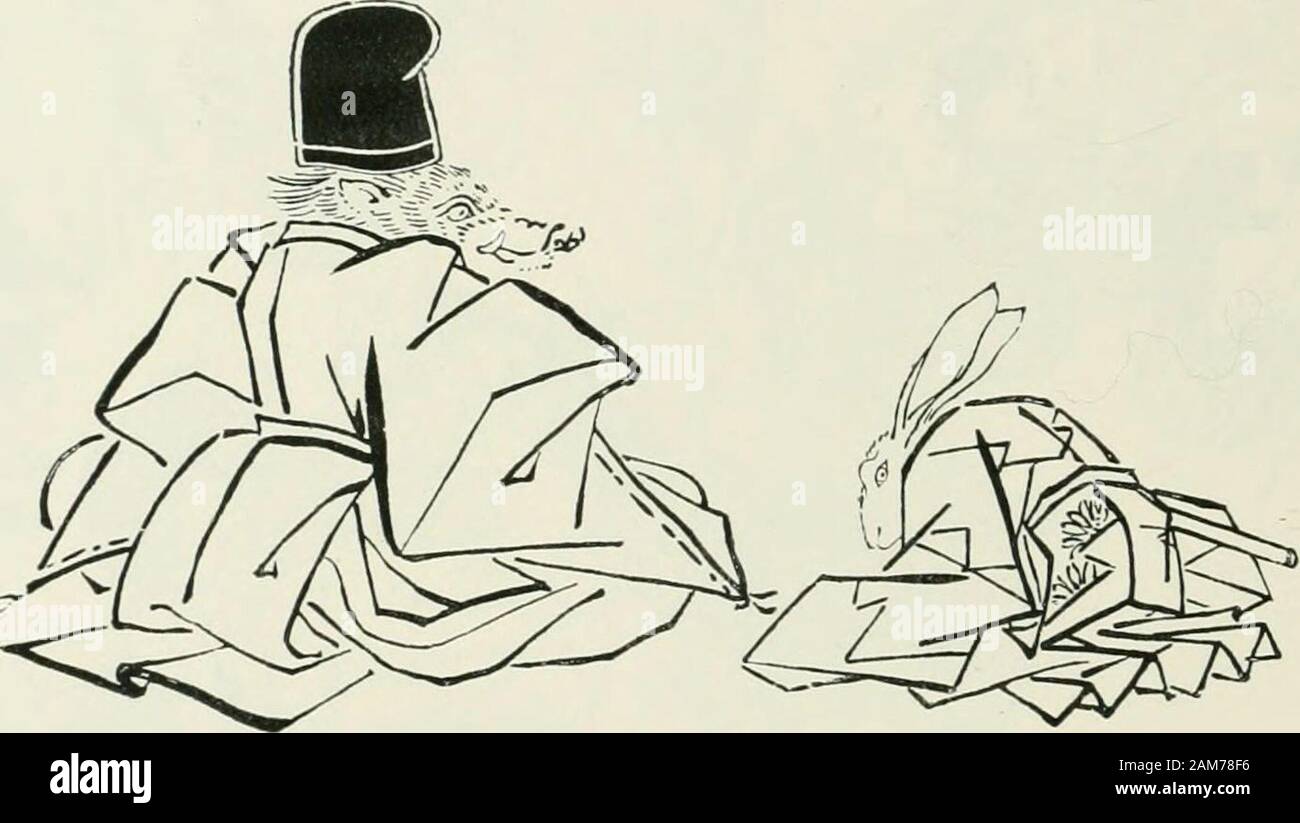 Japan and the Japanese illustrated . that he cannot abate a farthing in the piicc.The shopmen are carrying the bales, of which the purchaser is taking an invoice, ontheir shoulders. The money is in little straw bags, which the coolies cany atthe ends of their bamboos. Everything is conducted with the order and regularity 344 LIFE IN JAPAX. becoming to a great house. The smallest details are drawn with the care which wouldbe bestowed upon a serious composition. It is in this kind of comic art, childish orheroic by turns, that the Japanese display most ease and originality. I frequently noticed Stock Photohttps://www.alamy.com/image-license-details/?v=1https://www.alamy.com/japan-and-the-japanese-illustrated-that-he-cannot-abate-a-farthing-in-the-piiccthe-shopmen-are-carrying-the-bales-of-which-the-purchaser-is-taking-an-invoice-ontheir-shoulders-the-money-is-in-little-straw-bags-which-the-coolies-cany-atthe-ends-of-their-bamboos-everything-is-conducted-with-the-order-and-regularity-344-life-in-japax-becoming-to-a-great-house-the-smallest-details-are-drawn-with-the-care-which-wouldbe-bestowed-upon-a-serious-composition-it-is-in-this-kind-of-comic-art-childish-orheroic-by-turns-that-the-japanese-display-most-ease-and-originality-i-frequently-noticed-image339450474.html
Japan and the Japanese illustrated . that he cannot abate a farthing in the piicc.The shopmen are carrying the bales, of which the purchaser is taking an invoice, ontheir shoulders. The money is in little straw bags, which the coolies cany atthe ends of their bamboos. Everything is conducted with the order and regularity 344 LIFE IN JAPAX. becoming to a great house. The smallest details are drawn with the care which wouldbe bestowed upon a serious composition. It is in this kind of comic art, childish orheroic by turns, that the Japanese display most ease and originality. I frequently noticed Stock Photohttps://www.alamy.com/image-license-details/?v=1https://www.alamy.com/japan-and-the-japanese-illustrated-that-he-cannot-abate-a-farthing-in-the-piiccthe-shopmen-are-carrying-the-bales-of-which-the-purchaser-is-taking-an-invoice-ontheir-shoulders-the-money-is-in-little-straw-bags-which-the-coolies-cany-atthe-ends-of-their-bamboos-everything-is-conducted-with-the-order-and-regularity-344-life-in-japax-becoming-to-a-great-house-the-smallest-details-are-drawn-with-the-care-which-wouldbe-bestowed-upon-a-serious-composition-it-is-in-this-kind-of-comic-art-childish-orheroic-by-turns-that-the-japanese-display-most-ease-and-originality-i-frequently-noticed-image339450474.htmlRM2AM78F6–Japan and the Japanese illustrated . that he cannot abate a farthing in the piicc.The shopmen are carrying the bales, of which the purchaser is taking an invoice, ontheir shoulders. The money is in little straw bags, which the coolies cany atthe ends of their bamboos. Everything is conducted with the order and regularity 344 LIFE IN JAPAX. becoming to a great house. The smallest details are drawn with the care which wouldbe bestowed upon a serious composition. It is in this kind of comic art, childish orheroic by turns, that the Japanese display most ease and originality. I frequently noticed
 R.A.F. MAN RESCUED FROM JAPANESE PRISON CAMP - Picture (issued 1945) shows - Aircraftman/1 David Hallam, R.A.F. of 58 Portland Avenue, Bolsover, Chesterfield, who has just arrived home after nearly three years of hardship in Japanese prison camps. He was captured in February 1942, while in hospital at Singapore. With other British and Dutch prisoners and Malayan coolies he was put to work on building the Bangkok/Moulmein supply line. This meant working from dawn till dusk on scanty rations and with no mechanical aids whatsoever/ The pay was roughly 4 1/2d. per day. Later he fell ill again when Stock Photohttps://www.alamy.com/image-license-details/?v=1https://www.alamy.com/raf-man-rescued-from-japanese-prison-camp-picture-issued-1945-shows-aircraftman1-david-hallam-raf-of-58-portland-avenue-bolsover-chesterfield-who-has-just-arrived-home-after-nearly-three-years-of-hardship-in-japanese-prison-camps-he-was-captured-in-february-1942-while-in-hospital-at-singapore-with-other-british-and-dutch-prisoners-and-malayan-coolies-he-was-put-to-work-on-building-the-bangkokmoulmein-supply-line-this-meant-working-from-dawn-till-dusk-on-scanty-rations-and-with-no-mechanical-aids-whatsoever-the-pay-was-roughly-4-12d-per-day-later-he-fell-ill-again-when-image603426471.html
R.A.F. MAN RESCUED FROM JAPANESE PRISON CAMP - Picture (issued 1945) shows - Aircraftman/1 David Hallam, R.A.F. of 58 Portland Avenue, Bolsover, Chesterfield, who has just arrived home after nearly three years of hardship in Japanese prison camps. He was captured in February 1942, while in hospital at Singapore. With other British and Dutch prisoners and Malayan coolies he was put to work on building the Bangkok/Moulmein supply line. This meant working from dawn till dusk on scanty rations and with no mechanical aids whatsoever/ The pay was roughly 4 1/2d. per day. Later he fell ill again when Stock Photohttps://www.alamy.com/image-license-details/?v=1https://www.alamy.com/raf-man-rescued-from-japanese-prison-camp-picture-issued-1945-shows-aircraftman1-david-hallam-raf-of-58-portland-avenue-bolsover-chesterfield-who-has-just-arrived-home-after-nearly-three-years-of-hardship-in-japanese-prison-camps-he-was-captured-in-february-1942-while-in-hospital-at-singapore-with-other-british-and-dutch-prisoners-and-malayan-coolies-he-was-put-to-work-on-building-the-bangkokmoulmein-supply-line-this-meant-working-from-dawn-till-dusk-on-scanty-rations-and-with-no-mechanical-aids-whatsoever-the-pay-was-roughly-4-12d-per-day-later-he-fell-ill-again-when-image603426471.htmlRM2X1MCHB–R.A.F. MAN RESCUED FROM JAPANESE PRISON CAMP - Picture (issued 1945) shows - Aircraftman/1 David Hallam, R.A.F. of 58 Portland Avenue, Bolsover, Chesterfield, who has just arrived home after nearly three years of hardship in Japanese prison camps. He was captured in February 1942, while in hospital at Singapore. With other British and Dutch prisoners and Malayan coolies he was put to work on building the Bangkok/Moulmein supply line. This meant working from dawn till dusk on scanty rations and with no mechanical aids whatsoever/ The pay was roughly 4 1/2d. per day. Later he fell ill again when
 Asia, Japan, Kanazawa Ishikawa, Kenrokuen Garden Stock Photohttps://www.alamy.com/image-license-details/?v=1https://www.alamy.com/asia-japan-kanazawa-ishikawa-kenrokuen-garden-image239166799.html
Asia, Japan, Kanazawa Ishikawa, Kenrokuen Garden Stock Photohttps://www.alamy.com/image-license-details/?v=1https://www.alamy.com/asia-japan-kanazawa-ishikawa-kenrokuen-garden-image239166799.htmlRMRW2YKB–Asia, Japan, Kanazawa Ishikawa, Kenrokuen Garden
 Coolies Wayside Refreshments, Kusakabe Kimbei (Japanese, 1841 - 1934, active 1880s - about 1912), Japan, 1870s reimagined Stock Photohttps://www.alamy.com/image-license-details/?v=1https://www.alamy.com/coolies-wayside-refreshments-kusakabe-kimbei-japanese-1841-1934-active-1880s-about-1912-japan-1870s-reimagined-image230243369.html
Coolies Wayside Refreshments, Kusakabe Kimbei (Japanese, 1841 - 1934, active 1880s - about 1912), Japan, 1870s reimagined Stock Photohttps://www.alamy.com/image-license-details/?v=1https://www.alamy.com/coolies-wayside-refreshments-kusakabe-kimbei-japanese-1841-1934-active-1880s-about-1912-japan-1870s-reimagined-image230243369.htmlRFRAGDND–Coolies Wayside Refreshments, Kusakabe Kimbei (Japanese, 1841 - 1934, active 1880s - about 1912), Japan, 1870s reimagined
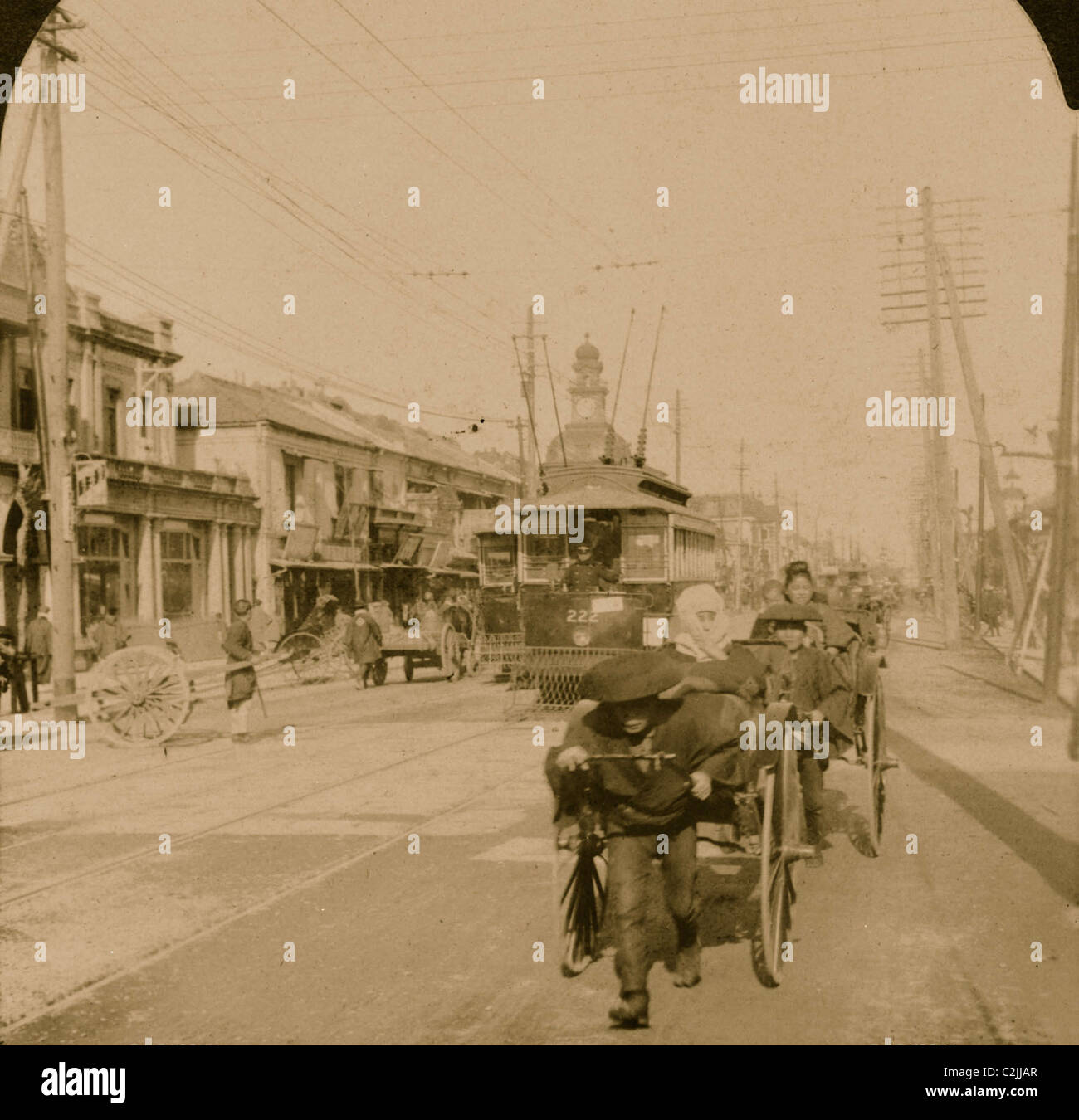 Ginza Street, the chief commercial thoroughfare of Tokyo, Japan Stock Photohttps://www.alamy.com/image-license-details/?v=1https://www.alamy.com/stock-photo-ginza-street-the-chief-commercial-thoroughfare-of-tokyo-japan-36059599.html
Ginza Street, the chief commercial thoroughfare of Tokyo, Japan Stock Photohttps://www.alamy.com/image-license-details/?v=1https://www.alamy.com/stock-photo-ginza-street-the-chief-commercial-thoroughfare-of-tokyo-japan-36059599.htmlRMC2JJAR–Ginza Street, the chief commercial thoroughfare of Tokyo, Japan
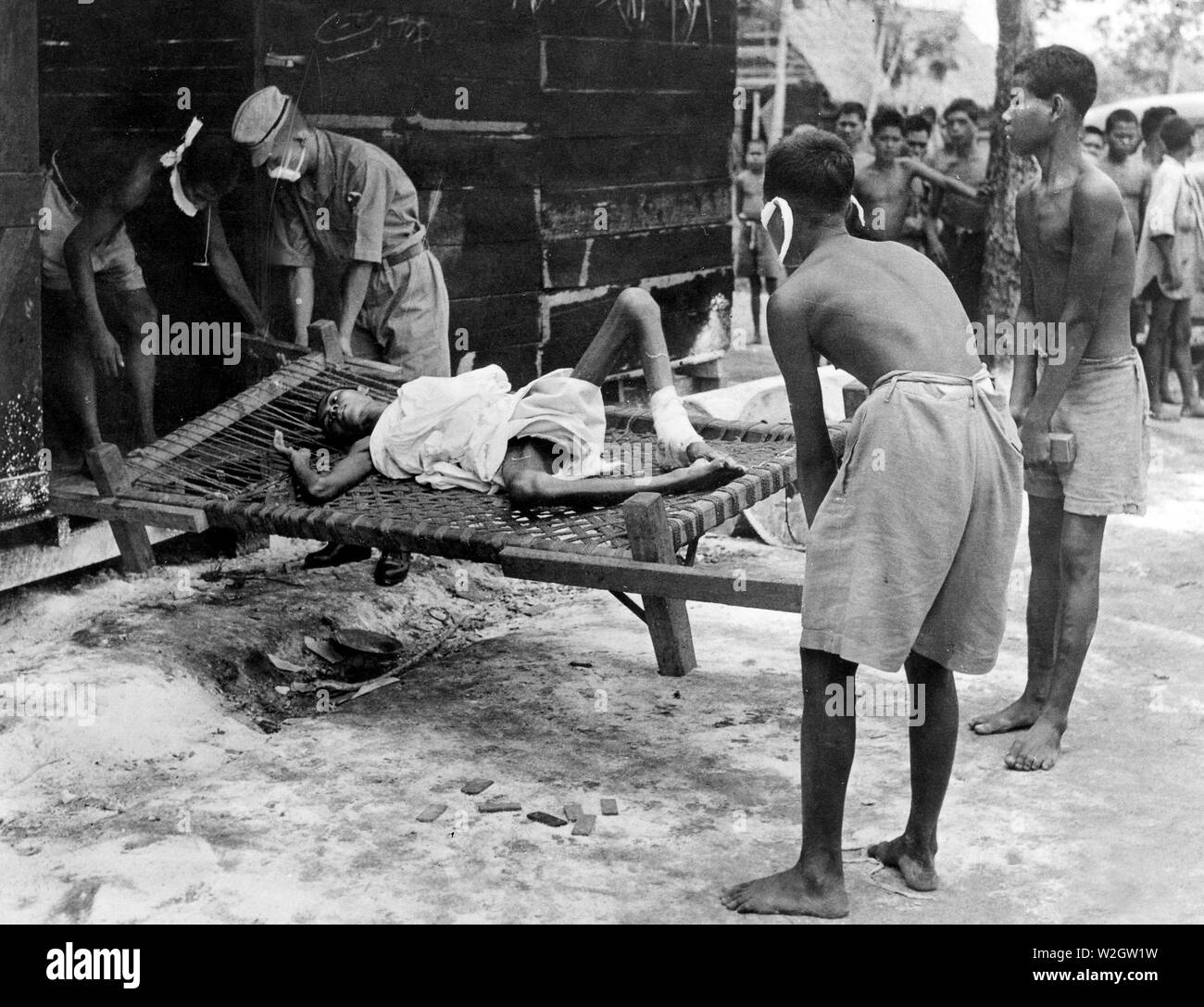 An emaciated coolie too weak to walk is carried on a charpoy by fellow-coolies at the Japanese labor camp at Seletah, in the northern part of Singapore. Populated by about 1700 persons, including Javanese, the camp was discovered by the British accidentally. With their arrival an effort was made to clean up the camp and administer to the sick. Stock Photohttps://www.alamy.com/image-license-details/?v=1https://www.alamy.com/an-emaciated-coolie-too-weak-to-walk-is-carried-on-a-charpoy-by-fellow-coolies-at-the-japanese-labor-camp-at-seletah-in-the-northern-part-of-singapore-populated-by-about-1700-persons-including-javanese-the-camp-was-discovered-by-the-british-accidentally-with-their-arrival-an-effort-was-made-to-clean-up-the-camp-and-administer-to-the-sick-image259755717.html
An emaciated coolie too weak to walk is carried on a charpoy by fellow-coolies at the Japanese labor camp at Seletah, in the northern part of Singapore. Populated by about 1700 persons, including Javanese, the camp was discovered by the British accidentally. With their arrival an effort was made to clean up the camp and administer to the sick. Stock Photohttps://www.alamy.com/image-license-details/?v=1https://www.alamy.com/an-emaciated-coolie-too-weak-to-walk-is-carried-on-a-charpoy-by-fellow-coolies-at-the-japanese-labor-camp-at-seletah-in-the-northern-part-of-singapore-populated-by-about-1700-persons-including-javanese-the-camp-was-discovered-by-the-british-accidentally-with-their-arrival-an-effort-was-made-to-clean-up-the-camp-and-administer-to-the-sick-image259755717.htmlRMW2GW1W–An emaciated coolie too weak to walk is carried on a charpoy by fellow-coolies at the Japanese labor camp at Seletah, in the northern part of Singapore. Populated by about 1700 persons, including Javanese, the camp was discovered by the British accidentally. With their arrival an effort was made to clean up the camp and administer to the sick.
 Korean coolie carrying medical supplies Stock Photohttps://www.alamy.com/image-license-details/?v=1https://www.alamy.com/stock-photo-korean-coolie-carrying-medical-supplies-36062648.html
Korean coolie carrying medical supplies Stock Photohttps://www.alamy.com/image-license-details/?v=1https://www.alamy.com/stock-photo-korean-coolie-carrying-medical-supplies-36062648.htmlRMC2JP7M–Korean coolie carrying medical supplies
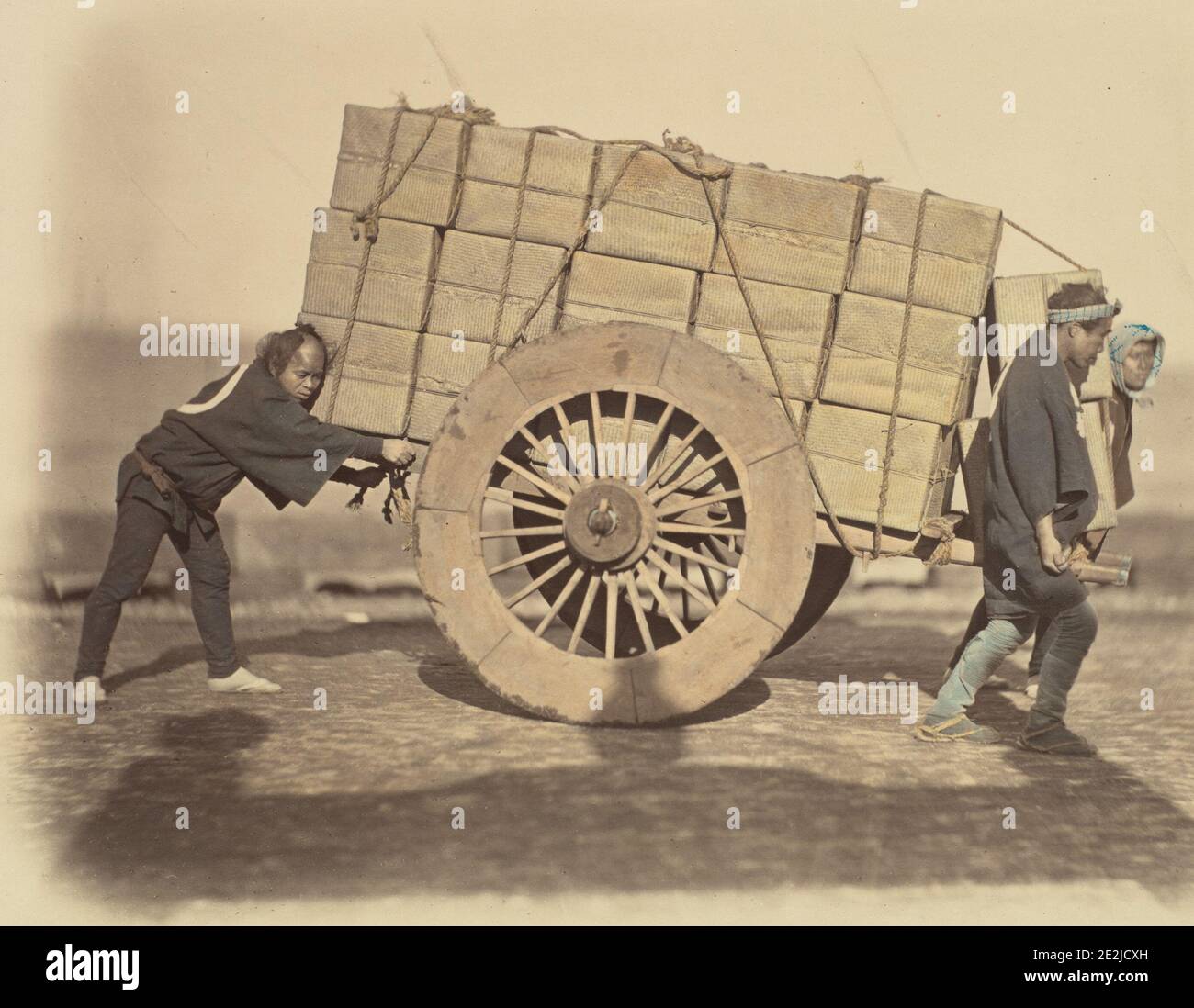 Shariki, or Cart-Pushing Coolies, ca. 1860. Stock Photohttps://www.alamy.com/image-license-details/?v=1https://www.alamy.com/shariki-or-cart-pushing-coolies-ca-1860-image397473065.html
Shariki, or Cart-Pushing Coolies, ca. 1860. Stock Photohttps://www.alamy.com/image-license-details/?v=1https://www.alamy.com/shariki-or-cart-pushing-coolies-ca-1860-image397473065.htmlRM2E2JCXH–Shariki, or Cart-Pushing Coolies, ca. 1860.
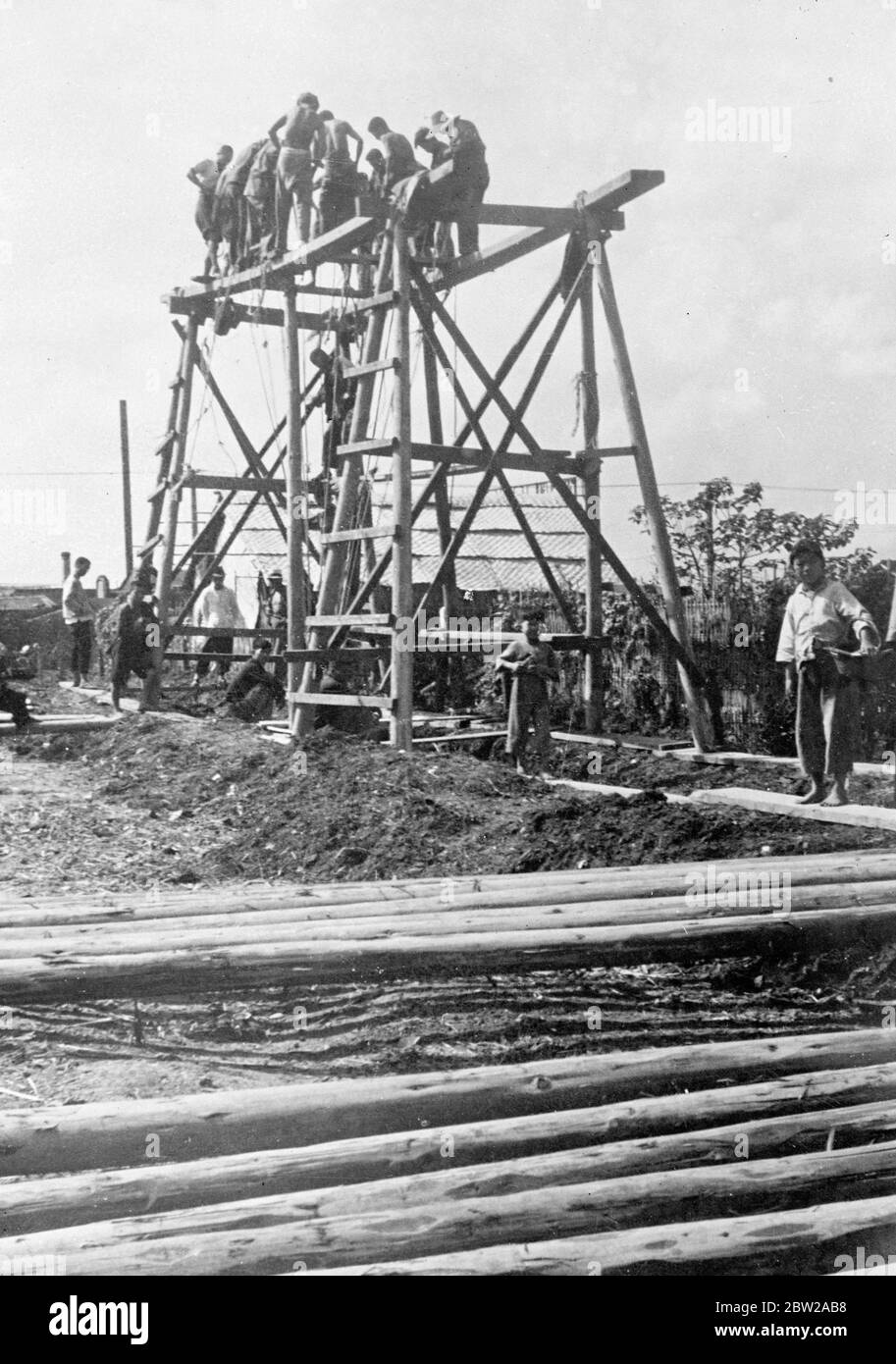 'Rice power' builds wall around French concession at Shanghai, primitive pile-driver used by modern engineers. Primitive method of pile driving, many hundreds of years old, is being used on the construction by the French of a brick wall to protect the French concession along the boundary with Nantao and Siccawei at Shanghai. The 'rice power' pile driver, as it is called, consist of a heavy stone, which is pulled up by coolies tugging in unison to an ancient chant. When it had been pulled up, the stone is allowed to fall on the pile. Photo shows, coolies hauling on the stone from the top of the Stock Photohttps://www.alamy.com/image-license-details/?v=1https://www.alamy.com/rice-power-builds-wall-around-french-concession-at-shanghai-primitive-pile-driver-used-by-modern-engineers-primitive-method-of-pile-driving-many-hundreds-of-years-old-is-being-used-on-the-construction-by-the-french-of-a-brick-wall-to-protect-the-french-concession-along-the-boundary-with-nantao-and-siccawei-at-shanghai-the-rice-power-pile-driver-as-it-is-called-consist-of-a-heavy-stone-which-is-pulled-up-by-coolies-tugging-in-unison-to-an-ancient-chant-when-it-had-been-pulled-up-the-stone-is-allowed-to-fall-on-the-pile-photo-shows-coolies-hauling-on-the-stone-from-the-top-of-the-image359625820.html
'Rice power' builds wall around French concession at Shanghai, primitive pile-driver used by modern engineers. Primitive method of pile driving, many hundreds of years old, is being used on the construction by the French of a brick wall to protect the French concession along the boundary with Nantao and Siccawei at Shanghai. The 'rice power' pile driver, as it is called, consist of a heavy stone, which is pulled up by coolies tugging in unison to an ancient chant. When it had been pulled up, the stone is allowed to fall on the pile. Photo shows, coolies hauling on the stone from the top of the Stock Photohttps://www.alamy.com/image-license-details/?v=1https://www.alamy.com/rice-power-builds-wall-around-french-concession-at-shanghai-primitive-pile-driver-used-by-modern-engineers-primitive-method-of-pile-driving-many-hundreds-of-years-old-is-being-used-on-the-construction-by-the-french-of-a-brick-wall-to-protect-the-french-concession-along-the-boundary-with-nantao-and-siccawei-at-shanghai-the-rice-power-pile-driver-as-it-is-called-consist-of-a-heavy-stone-which-is-pulled-up-by-coolies-tugging-in-unison-to-an-ancient-chant-when-it-had-been-pulled-up-the-stone-is-allowed-to-fall-on-the-pile-photo-shows-coolies-hauling-on-the-stone-from-the-top-of-the-image359625820.htmlRM2BW2AB8–'Rice power' builds wall around French concession at Shanghai, primitive pile-driver used by modern engineers. Primitive method of pile driving, many hundreds of years old, is being used on the construction by the French of a brick wall to protect the French concession along the boundary with Nantao and Siccawei at Shanghai. The 'rice power' pile driver, as it is called, consist of a heavy stone, which is pulled up by coolies tugging in unison to an ancient chant. When it had been pulled up, the stone is allowed to fall on the pile. Photo shows, coolies hauling on the stone from the top of the
 Japan and the Japanese illustrated . of the beggars, the cadencedcries of the coolies, and the confused noises which come up from the canal, forma strange harmony, unlike the sounds of any other cities. All great cities havea voice of their own. In Loadon it is like the surge of the rising tide; atYeddo, it is like the murmur of a stream. As wave follows wave, so do generationssucceed each other. That wliicli I liavc under my eyes is passing away and dis-appearing, cariying with it all that its ancestors bequeathed to it ; oljjects ofworship, ancient costumes, old arms, laws which dated from c Stock Photohttps://www.alamy.com/image-license-details/?v=1https://www.alamy.com/japan-and-the-japanese-illustrated-of-the-beggars-the-cadencedcries-of-the-coolies-and-the-confused-noises-which-come-up-from-the-canal-forma-strange-harmony-unlike-the-sounds-of-any-other-cities-all-great-cities-havea-voice-of-their-own-in-loadon-it-is-like-the-surge-of-the-rising-tide-atyeddo-it-is-like-the-murmur-of-a-stream-as-wave-follows-wave-so-do-generationssucceed-each-other-that-wliicli-i-liavc-under-my-eyes-is-passing-away-and-dis-appearing-cariying-with-it-all-that-its-ancestors-bequeathed-to-it-oljjects-ofworship-ancient-costumes-old-arms-laws-which-dated-from-c-image339885264.html
Japan and the Japanese illustrated . of the beggars, the cadencedcries of the coolies, and the confused noises which come up from the canal, forma strange harmony, unlike the sounds of any other cities. All great cities havea voice of their own. In Loadon it is like the surge of the rising tide; atYeddo, it is like the murmur of a stream. As wave follows wave, so do generationssucceed each other. That wliicli I liavc under my eyes is passing away and dis-appearing, cariying with it all that its ancestors bequeathed to it ; oljjects ofworship, ancient costumes, old arms, laws which dated from c Stock Photohttps://www.alamy.com/image-license-details/?v=1https://www.alamy.com/japan-and-the-japanese-illustrated-of-the-beggars-the-cadencedcries-of-the-coolies-and-the-confused-noises-which-come-up-from-the-canal-forma-strange-harmony-unlike-the-sounds-of-any-other-cities-all-great-cities-havea-voice-of-their-own-in-loadon-it-is-like-the-surge-of-the-rising-tide-atyeddo-it-is-like-the-murmur-of-a-stream-as-wave-follows-wave-so-do-generationssucceed-each-other-that-wliicli-i-liavc-under-my-eyes-is-passing-away-and-dis-appearing-cariying-with-it-all-that-its-ancestors-bequeathed-to-it-oljjects-ofworship-ancient-costumes-old-arms-laws-which-dated-from-c-image339885264.htmlRM2AMY33C–Japan and the Japanese illustrated . of the beggars, the cadencedcries of the coolies, and the confused noises which come up from the canal, forma strange harmony, unlike the sounds of any other cities. All great cities havea voice of their own. In Loadon it is like the surge of the rising tide; atYeddo, it is like the murmur of a stream. As wave follows wave, so do generationssucceed each other. That wliicli I liavc under my eyes is passing away and dis-appearing, cariying with it all that its ancestors bequeathed to it ; oljjects ofworship, ancient costumes, old arms, laws which dated from c
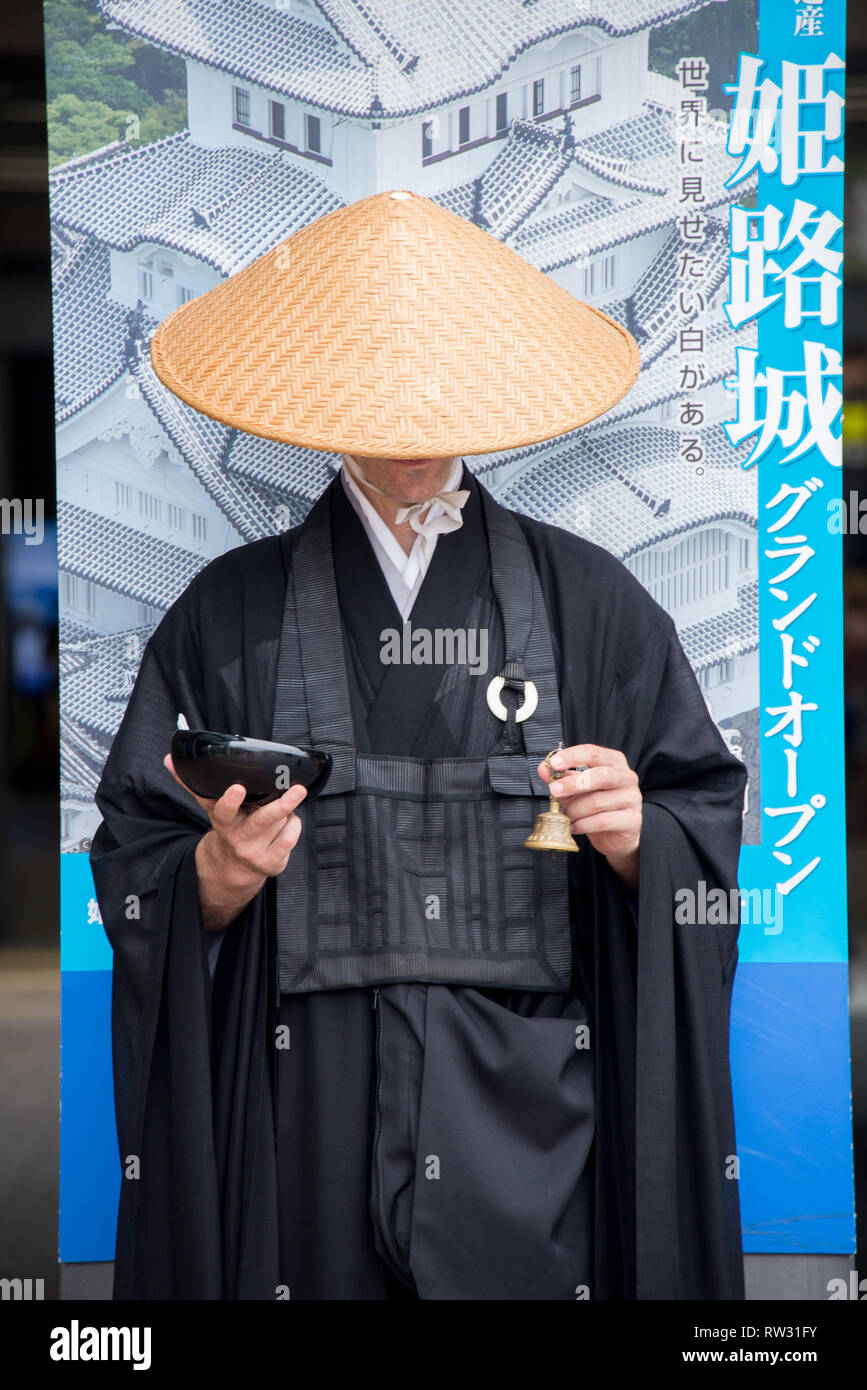 Asia, Japan, Himeji, monk Stock Photohttps://www.alamy.com/image-license-details/?v=1https://www.alamy.com/asia-japan-himeji-monk-image239168271.html
Asia, Japan, Himeji, monk Stock Photohttps://www.alamy.com/image-license-details/?v=1https://www.alamy.com/asia-japan-himeji-monk-image239168271.htmlRMRW31FY–Asia, Japan, Himeji, monk
 Sleeping quarters in a Japanese labor camp at Seletah, in the northern part of Singapore, are in thatched houses raised above the ground for protection against insects and reptiles. About 1700 coolies, many from Java, were brought here, assigned to enforced labor, and forced to live in filth and squalor until a British naval party accidentally found them. Stock Photohttps://www.alamy.com/image-license-details/?v=1https://www.alamy.com/sleeping-quarters-in-a-japanese-labor-camp-at-seletah-in-the-northern-part-of-singapore-are-in-thatched-houses-raised-above-the-ground-for-protection-against-insects-and-reptiles-about-1700-coolies-many-from-java-were-brought-here-assigned-to-enforced-labor-and-forced-to-live-in-filth-and-squalor-until-a-british-naval-party-accidentally-found-them-image259755790.html
Sleeping quarters in a Japanese labor camp at Seletah, in the northern part of Singapore, are in thatched houses raised above the ground for protection against insects and reptiles. About 1700 coolies, many from Java, were brought here, assigned to enforced labor, and forced to live in filth and squalor until a British naval party accidentally found them. Stock Photohttps://www.alamy.com/image-license-details/?v=1https://www.alamy.com/sleeping-quarters-in-a-japanese-labor-camp-at-seletah-in-the-northern-part-of-singapore-are-in-thatched-houses-raised-above-the-ground-for-protection-against-insects-and-reptiles-about-1700-coolies-many-from-java-were-brought-here-assigned-to-enforced-labor-and-forced-to-live-in-filth-and-squalor-until-a-british-naval-party-accidentally-found-them-image259755790.htmlRMW2GW4E–Sleeping quarters in a Japanese labor camp at Seletah, in the northern part of Singapore, are in thatched houses raised above the ground for protection against insects and reptiles. About 1700 coolies, many from Java, were brought here, assigned to enforced labor, and forced to live in filth and squalor until a British naval party accidentally found them.
 Coolies Wayside Refreshments, 1870s-1890s. Two seated men and two men standing, eating food that was transported in wicker baskets. Stock Photohttps://www.alamy.com/image-license-details/?v=1https://www.alamy.com/coolies-wayside-refreshments-1870s-1890s-two-seated-men-and-two-men-standing-eating-food-that-was-transported-in-wicker-baskets-image626623397.html
Coolies Wayside Refreshments, 1870s-1890s. Two seated men and two men standing, eating food that was transported in wicker baskets. Stock Photohttps://www.alamy.com/image-license-details/?v=1https://www.alamy.com/coolies-wayside-refreshments-1870s-1890s-two-seated-men-and-two-men-standing-eating-food-that-was-transported-in-wicker-baskets-image626623397.htmlRM2YBD4F1–Coolies Wayside Refreshments, 1870s-1890s. Two seated men and two men standing, eating food that was transported in wicker baskets.
 A shooting trip to Kamchatka . THE MAIN STREET, NIKOLAIEVSK. could be seen amongst the predominating massesof Chinese coolies, Japanese fishermen, or nativeGiliaks. Here also strolled numerous ex-convicts,mostly Caucasians who had * done time on TheIsland, and the most enterprising of whom had starteddifferent trades. One of the buildings appeared tous to surpass the others by its comparatively better 276 A SHOOTING TRIP TO KAMCHATKA condition. We learnt that this was the Club, chieflyused by officers stationed in the district, and enteredthe place in hope of obtaining fresh news. There we. A Stock Photohttps://www.alamy.com/image-license-details/?v=1https://www.alamy.com/a-shooting-trip-to-kamchatka-the-main-street-nikolaievsk-could-be-seen-amongst-the-predominating-massesof-chinese-coolies-japanese-fishermen-or-nativegiliaks-here-also-strolled-numerous-ex-convictsmostly-caucasians-who-had-done-time-on-theisland-and-the-most-enterprising-of-whom-had-starteddifferent-trades-one-of-the-buildings-appeared-tous-to-surpass-the-others-by-its-comparatively-better-276-a-shooting-trip-to-kamchatka-condition-we-learnt-that-this-was-the-club-chieflyused-by-officers-stationed-in-the-district-and-enteredthe-place-in-hope-of-obtaining-fresh-news-there-we-a-image339137956.html
A shooting trip to Kamchatka . THE MAIN STREET, NIKOLAIEVSK. could be seen amongst the predominating massesof Chinese coolies, Japanese fishermen, or nativeGiliaks. Here also strolled numerous ex-convicts,mostly Caucasians who had * done time on TheIsland, and the most enterprising of whom had starteddifferent trades. One of the buildings appeared tous to surpass the others by its comparatively better 276 A SHOOTING TRIP TO KAMCHATKA condition. We learnt that this was the Club, chieflyused by officers stationed in the district, and enteredthe place in hope of obtaining fresh news. There we. A Stock Photohttps://www.alamy.com/image-license-details/?v=1https://www.alamy.com/a-shooting-trip-to-kamchatka-the-main-street-nikolaievsk-could-be-seen-amongst-the-predominating-massesof-chinese-coolies-japanese-fishermen-or-nativegiliaks-here-also-strolled-numerous-ex-convictsmostly-caucasians-who-had-done-time-on-theisland-and-the-most-enterprising-of-whom-had-starteddifferent-trades-one-of-the-buildings-appeared-tous-to-surpass-the-others-by-its-comparatively-better-276-a-shooting-trip-to-kamchatka-condition-we-learnt-that-this-was-the-club-chieflyused-by-officers-stationed-in-the-district-and-enteredthe-place-in-hope-of-obtaining-fresh-news-there-we-a-image339137956.htmlRM2AKN1WT–A shooting trip to Kamchatka . THE MAIN STREET, NIKOLAIEVSK. could be seen amongst the predominating massesof Chinese coolies, Japanese fishermen, or nativeGiliaks. Here also strolled numerous ex-convicts,mostly Caucasians who had * done time on TheIsland, and the most enterprising of whom had starteddifferent trades. One of the buildings appeared tous to surpass the others by its comparatively better 276 A SHOOTING TRIP TO KAMCHATKA condition. We learnt that this was the Club, chieflyused by officers stationed in the district, and enteredthe place in hope of obtaining fresh news. There we. A
 Japan and the Japanese illustrated . ferings given to the bonzes. Ihen comes theturn of the coolies who have washed tlic body, of .those who have carried the coffin, andthe convent servants whose duties lie within the enclosure of the cemetery. JJutthis is not all ; a pious custom ordains tliat all persons of a certain station shall installa servant at the house door charged witli the distribution of alms, in small coins, to u 0 2 284 LIFE IN JAPAN all the poor, indiscriminately, who come to seek tliem. And also, on the return ofthe funeral procession, all the party are expected to take leave Stock Photohttps://www.alamy.com/image-license-details/?v=1https://www.alamy.com/japan-and-the-japanese-illustrated-ferings-given-to-the-bonzes-ihen-comes-theturn-of-the-coolies-who-have-washed-tlic-body-of-those-who-have-carried-the-coffin-andthe-convent-servants-whose-duties-lie-within-the-enclosure-of-the-cemetery-jjutthis-is-not-all-a-pious-custom-ordains-tliat-all-persons-of-a-certain-station-shall-installa-servant-at-the-house-door-charged-witli-the-distribution-of-alms-in-small-coins-to-u-0-2-284-life-in-japan-all-the-poor-indiscriminately-who-come-to-seek-tliem-and-also-on-the-return-ofthe-funeral-procession-all-the-party-are-expected-to-take-leave-image339466072.html
Japan and the Japanese illustrated . ferings given to the bonzes. Ihen comes theturn of the coolies who have washed tlic body, of .those who have carried the coffin, andthe convent servants whose duties lie within the enclosure of the cemetery. JJutthis is not all ; a pious custom ordains tliat all persons of a certain station shall installa servant at the house door charged witli the distribution of alms, in small coins, to u 0 2 284 LIFE IN JAPAN all the poor, indiscriminately, who come to seek tliem. And also, on the return ofthe funeral procession, all the party are expected to take leave Stock Photohttps://www.alamy.com/image-license-details/?v=1https://www.alamy.com/japan-and-the-japanese-illustrated-ferings-given-to-the-bonzes-ihen-comes-theturn-of-the-coolies-who-have-washed-tlic-body-of-those-who-have-carried-the-coffin-andthe-convent-servants-whose-duties-lie-within-the-enclosure-of-the-cemetery-jjutthis-is-not-all-a-pious-custom-ordains-tliat-all-persons-of-a-certain-station-shall-installa-servant-at-the-house-door-charged-witli-the-distribution-of-alms-in-small-coins-to-u-0-2-284-life-in-japan-all-the-poor-indiscriminately-who-come-to-seek-tliem-and-also-on-the-return-ofthe-funeral-procession-all-the-party-are-expected-to-take-leave-image339466072.htmlRM2AM80C8–Japan and the Japanese illustrated . ferings given to the bonzes. Ihen comes theturn of the coolies who have washed tlic body, of .those who have carried the coffin, andthe convent servants whose duties lie within the enclosure of the cemetery. JJutthis is not all ; a pious custom ordains tliat all persons of a certain station shall installa servant at the house door charged witli the distribution of alms, in small coins, to u 0 2 284 LIFE IN JAPAN all the poor, indiscriminately, who come to seek tliem. And also, on the return ofthe funeral procession, all the party are expected to take leave
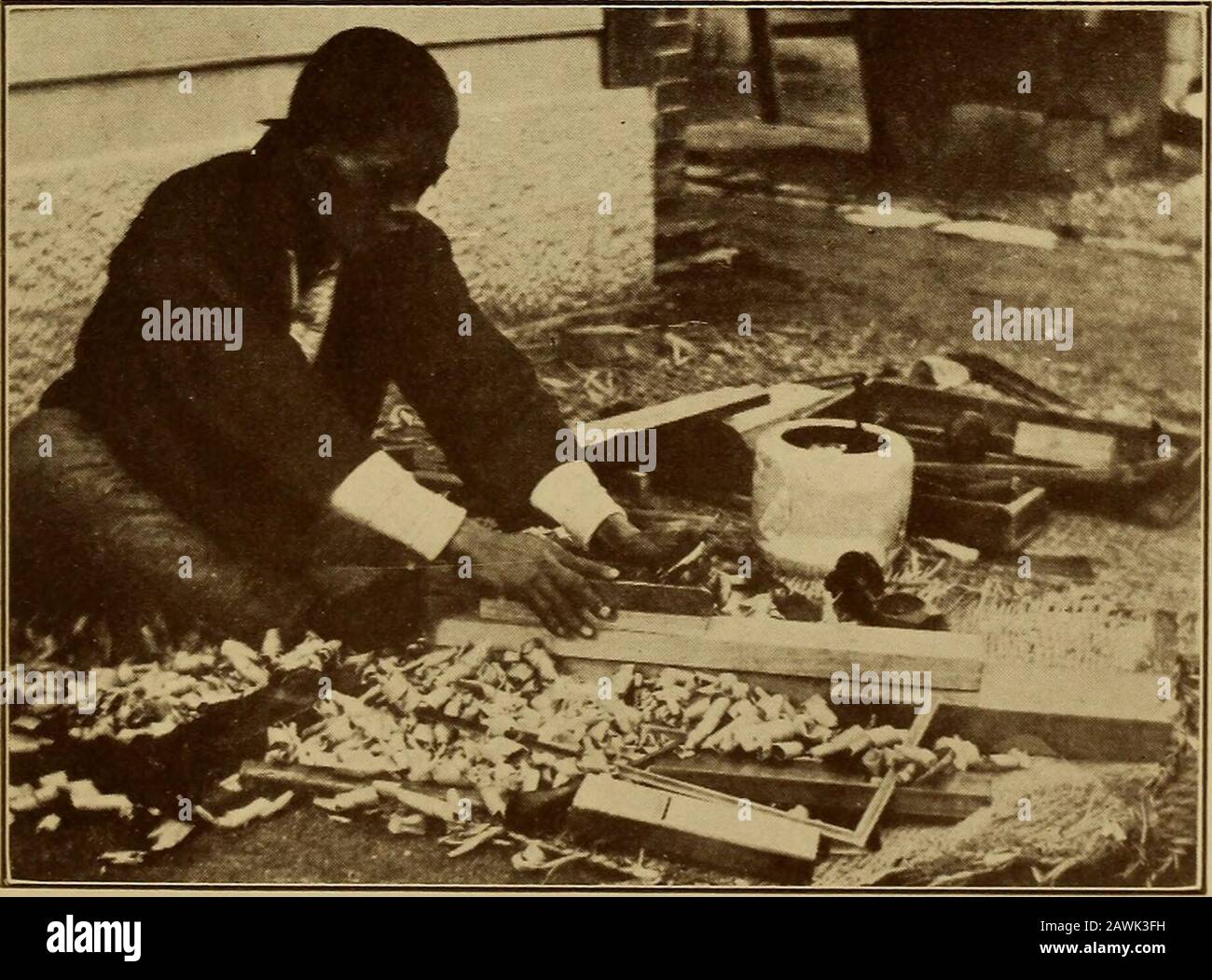 By Nippon's lotus ponds; pen pictures of real Japan . INTERIOR OF JAPANESE HOUSE. THE AGILE LITTLE CARPENTER FREQUENT « SIESTAS * 197 least evince much patience and a marvellous de-gree of skill in planing the most cross-grained andknotty board to a polish. Some of his tools are ofa Western type, others are ingeniously native. Oneof the much-used tools is the adz, with which, whentwo or three men are edging a log, their strokes arealternate and as regular in measure as when they(hammer nails, or when the farmers thrash withflail, or a few coolies pound rice mochi, or a gangof four or five sect Stock Photohttps://www.alamy.com/image-license-details/?v=1https://www.alamy.com/by-nippons-lotus-ponds-pen-pictures-of-real-japan-interior-of-japanese-house-the-agile-little-carpenter-frequent-siestas-197-least-evince-much-patience-and-a-marvellous-de-gree-of-skill-in-planing-the-most-cross-grained-andknotty-board-to-a-polish-some-of-his-tools-are-ofa-western-type-others-are-ingeniously-native-oneof-the-much-used-tools-is-the-adz-with-which-whentwo-or-three-men-are-edging-a-log-their-strokes-arealternate-and-as-regular-in-measure-as-when-theyhammer-nails-or-when-the-farmers-thrash-withflail-or-a-few-coolies-pound-rice-mochi-or-a-gangof-four-or-five-sect-image342783269.html
By Nippon's lotus ponds; pen pictures of real Japan . INTERIOR OF JAPANESE HOUSE. THE AGILE LITTLE CARPENTER FREQUENT « SIESTAS * 197 least evince much patience and a marvellous de-gree of skill in planing the most cross-grained andknotty board to a polish. Some of his tools are ofa Western type, others are ingeniously native. Oneof the much-used tools is the adz, with which, whentwo or three men are edging a log, their strokes arealternate and as regular in measure as when they(hammer nails, or when the farmers thrash withflail, or a few coolies pound rice mochi, or a gangof four or five sect Stock Photohttps://www.alamy.com/image-license-details/?v=1https://www.alamy.com/by-nippons-lotus-ponds-pen-pictures-of-real-japan-interior-of-japanese-house-the-agile-little-carpenter-frequent-siestas-197-least-evince-much-patience-and-a-marvellous-de-gree-of-skill-in-planing-the-most-cross-grained-andknotty-board-to-a-polish-some-of-his-tools-are-ofa-western-type-others-are-ingeniously-native-oneof-the-much-used-tools-is-the-adz-with-which-whentwo-or-three-men-are-edging-a-log-their-strokes-arealternate-and-as-regular-in-measure-as-when-theyhammer-nails-or-when-the-farmers-thrash-withflail-or-a-few-coolies-pound-rice-mochi-or-a-gangof-four-or-five-sect-image342783269.htmlRM2AWK3FH–By Nippon's lotus ponds; pen pictures of real Japan . INTERIOR OF JAPANESE HOUSE. THE AGILE LITTLE CARPENTER FREQUENT « SIESTAS * 197 least evince much patience and a marvellous de-gree of skill in planing the most cross-grained andknotty board to a polish. Some of his tools are ofa Western type, others are ingeniously native. Oneof the much-used tools is the adz, with which, whentwo or three men are edging a log, their strokes arealternate and as regular in measure as when they(hammer nails, or when the farmers thrash withflail, or a few coolies pound rice mochi, or a gangof four or five sect
 . Niphon and Pe-che-li; or, Two years in Japan and northern China. imon-bearers,bettos, coolies, servants, and followers, togetherwith a troop of pack-horses, swelled our cortegeto the dimensions of a small invading army. Mr. Alcock, although he had of necessityasked the Japanese Government to make arrange-ments for our comfort and security en route, hadstipulated that he should be as little as possibleembarrassed by the presence of officials, as hewished to travel niebon. There was none of thestate, accordingly, with which a Japanese func-tionary of any rank would have surrounded him-self in Stock Photohttps://www.alamy.com/image-license-details/?v=1https://www.alamy.com/niphon-and-pe-che-li-or-two-years-in-japan-and-northern-china-imon-bearersbettos-coolies-servants-and-followers-togetherwith-a-troop-of-pack-horses-swelled-our-cortegeto-the-dimensions-of-a-small-invading-army-mr-alcock-although-he-had-of-necessityasked-the-japanese-government-to-make-arrange-ments-for-our-comfort-and-security-en-route-hadstipulated-that-he-should-be-as-little-as-possibleembarrassed-by-the-presence-of-officials-as-hewished-to-travel-niebon-there-was-none-of-thestate-accordingly-with-which-a-japanese-func-tionary-of-any-rank-would-have-surrounded-him-self-in-image370523735.html
. Niphon and Pe-che-li; or, Two years in Japan and northern China. imon-bearers,bettos, coolies, servants, and followers, togetherwith a troop of pack-horses, swelled our cortegeto the dimensions of a small invading army. Mr. Alcock, although he had of necessityasked the Japanese Government to make arrange-ments for our comfort and security en route, hadstipulated that he should be as little as possibleembarrassed by the presence of officials, as hewished to travel niebon. There was none of thestate, accordingly, with which a Japanese func-tionary of any rank would have surrounded him-self in Stock Photohttps://www.alamy.com/image-license-details/?v=1https://www.alamy.com/niphon-and-pe-che-li-or-two-years-in-japan-and-northern-china-imon-bearersbettos-coolies-servants-and-followers-togetherwith-a-troop-of-pack-horses-swelled-our-cortegeto-the-dimensions-of-a-small-invading-army-mr-alcock-although-he-had-of-necessityasked-the-japanese-government-to-make-arrange-ments-for-our-comfort-and-security-en-route-hadstipulated-that-he-should-be-as-little-as-possibleembarrassed-by-the-presence-of-officials-as-hewished-to-travel-niebon-there-was-none-of-thestate-accordingly-with-which-a-japanese-func-tionary-of-any-rank-would-have-surrounded-him-self-in-image370523735.htmlRM2CEPPPF–. Niphon and Pe-che-li; or, Two years in Japan and northern China. imon-bearers,bettos, coolies, servants, and followers, togetherwith a troop of pack-horses, swelled our cortegeto the dimensions of a small invading army. Mr. Alcock, although he had of necessityasked the Japanese Government to make arrange-ments for our comfort and security en route, hadstipulated that he should be as little as possibleembarrassed by the presence of officials, as hewished to travel niebon. There was none of thestate, accordingly, with which a Japanese func-tionary of any rank would have surrounded him-self in
 . In brightest Asia. llow-travellersrepresent — pleasure seekers, traders with oriental houses, and shippers of Chinese coolies. Wehope for less sneering during the rest of the voyage. We had several Chinese and Japanese atservice, and they were among our most attentive listeners. Two of these especially give evidenceof being genuine Christians — Lo Jo, the Chinese boy, and Mr. Abe, the Japanese boy. Thelatter I found yesterday in the prow of the ship, flat down on his stomach, reading the Acts ofthe Apostles. His shipmates were gaming near by him. Both these boys have often joined usat evenin Stock Photohttps://www.alamy.com/image-license-details/?v=1https://www.alamy.com/in-brightest-asia-llow-travellersrepresent-pleasure-seekers-traders-with-oriental-houses-and-shippers-of-chinese-coolies-wehope-for-less-sneering-during-the-rest-of-the-voyage-we-had-several-chinese-and-japanese-atservice-and-they-were-among-our-most-attentive-listeners-two-of-these-especially-give-evidenceof-being-genuine-christians-lo-jo-the-chinese-boy-and-mr-abe-the-japanese-boy-thelatter-i-found-yesterday-in-the-prow-of-the-ship-flat-down-on-his-stomach-reading-the-acts-ofthe-apostles-his-shipmates-were-gaming-near-by-him-both-these-boys-have-often-joined-usat-evenin-image370621304.html
. In brightest Asia. llow-travellersrepresent — pleasure seekers, traders with oriental houses, and shippers of Chinese coolies. Wehope for less sneering during the rest of the voyage. We had several Chinese and Japanese atservice, and they were among our most attentive listeners. Two of these especially give evidenceof being genuine Christians — Lo Jo, the Chinese boy, and Mr. Abe, the Japanese boy. Thelatter I found yesterday in the prow of the ship, flat down on his stomach, reading the Acts ofthe Apostles. His shipmates were gaming near by him. Both these boys have often joined usat evenin Stock Photohttps://www.alamy.com/image-license-details/?v=1https://www.alamy.com/in-brightest-asia-llow-travellersrepresent-pleasure-seekers-traders-with-oriental-houses-and-shippers-of-chinese-coolies-wehope-for-less-sneering-during-the-rest-of-the-voyage-we-had-several-chinese-and-japanese-atservice-and-they-were-among-our-most-attentive-listeners-two-of-these-especially-give-evidenceof-being-genuine-christians-lo-jo-the-chinese-boy-and-mr-abe-the-japanese-boy-thelatter-i-found-yesterday-in-the-prow-of-the-ship-flat-down-on-his-stomach-reading-the-acts-ofthe-apostles-his-shipmates-were-gaming-near-by-him-both-these-boys-have-often-joined-usat-evenin-image370621304.htmlRM2CEY774–. In brightest Asia. llow-travellersrepresent — pleasure seekers, traders with oriental houses, and shippers of Chinese coolies. Wehope for less sneering during the rest of the voyage. We had several Chinese and Japanese atservice, and they were among our most attentive listeners. Two of these especially give evidenceof being genuine Christians — Lo Jo, the Chinese boy, and Mr. Abe, the Japanese boy. Thelatter I found yesterday in the prow of the ship, flat down on his stomach, reading the Acts ofthe Apostles. His shipmates were gaming near by him. Both these boys have often joined usat evenin
 . American forestry. Forests and forestry. 490 AMERICAN FORESTRY. JAPANESE FOREST DEPARTMENT OFFICIALS IN UNIFORM AND COOLIES IN THE BAMBOO STAND NEAR ARISAN, FOR- MOSA. ernment monopoly since 1899. in the Chinese regime, the crude and wasteful method of manufacture adopted by the Chinese camphor producer has been re- placed by the advanced Japanese proc- ess, while in order to keep up a suffi- cient supply of material, efforts are be- ing made towards propagation of the tree, by establishing nurseries in vari- ous parts of the island, the camphor forest thus being maintained with splen- did r Stock Photohttps://www.alamy.com/image-license-details/?v=1https://www.alamy.com/american-forestry-forests-and-forestry-490-american-forestry-japanese-forest-department-officials-in-uniform-and-coolies-in-the-bamboo-stand-near-arisan-for-mosa-ernment-monopoly-since-1899-in-the-chinese-regime-the-crude-and-wasteful-method-of-manufacture-adopted-by-the-chinese-camphor-producer-has-been-re-placed-by-the-advanced-japanese-proc-ess-while-in-order-to-keep-up-a-suffi-cient-supply-of-material-efforts-are-be-ing-made-towards-propagation-of-the-tree-by-establishing-nurseries-in-vari-ous-parts-of-the-island-the-camphor-forest-thus-being-maintained-with-splen-did-r-image237248774.html
. American forestry. Forests and forestry. 490 AMERICAN FORESTRY. JAPANESE FOREST DEPARTMENT OFFICIALS IN UNIFORM AND COOLIES IN THE BAMBOO STAND NEAR ARISAN, FOR- MOSA. ernment monopoly since 1899. in the Chinese regime, the crude and wasteful method of manufacture adopted by the Chinese camphor producer has been re- placed by the advanced Japanese proc- ess, while in order to keep up a suffi- cient supply of material, efforts are be- ing made towards propagation of the tree, by establishing nurseries in vari- ous parts of the island, the camphor forest thus being maintained with splen- did r Stock Photohttps://www.alamy.com/image-license-details/?v=1https://www.alamy.com/american-forestry-forests-and-forestry-490-american-forestry-japanese-forest-department-officials-in-uniform-and-coolies-in-the-bamboo-stand-near-arisan-for-mosa-ernment-monopoly-since-1899-in-the-chinese-regime-the-crude-and-wasteful-method-of-manufacture-adopted-by-the-chinese-camphor-producer-has-been-re-placed-by-the-advanced-japanese-proc-ess-while-in-order-to-keep-up-a-suffi-cient-supply-of-material-efforts-are-be-ing-made-towards-propagation-of-the-tree-by-establishing-nurseries-in-vari-ous-parts-of-the-island-the-camphor-forest-thus-being-maintained-with-splen-did-r-image237248774.htmlRMRNYH6E–. American forestry. Forests and forestry. 490 AMERICAN FORESTRY. JAPANESE FOREST DEPARTMENT OFFICIALS IN UNIFORM AND COOLIES IN THE BAMBOO STAND NEAR ARISAN, FOR- MOSA. ernment monopoly since 1899. in the Chinese regime, the crude and wasteful method of manufacture adopted by the Chinese camphor producer has been re- placed by the advanced Japanese proc- ess, while in order to keep up a suffi- cient supply of material, efforts are be- ing made towards propagation of the tree, by establishing nurseries in vari- ous parts of the island, the camphor forest thus being maintained with splen- did r